Contemporary Living Room Design: 67 Stylish Ideas For A Modern Space

What elements define a breathtaking design of a contemporary living room? Is it the clean and unembellished look, the carefully placed accessories, or the spatial arrangement of materials? In this article, I discuss how to design living rooms that incorporate coziness while still feeling modern and effortless through the use of texture, natural light, and greenery. These concepts will transform your home into a contemporary haven, no matter if you have a spacious or compact floor plan.
Let us take a look into some of the most captivating and practical approaches to living room designs that are visually appealing and functional.
Embracing Minimalism With Purposeful Design
For contemporary living rooms with a minimalist design approach, I prioritize achieving a sense calm while ensuring there is still significant character to grab attention. Contrary to popular belief, minimalist contemporary design does not equate to cold, barren furniture; rather, it forms curated spaces that feel deliberate. As with all designs I work on, I ensure there’s a purpose to every piece—balance with negative space is key.
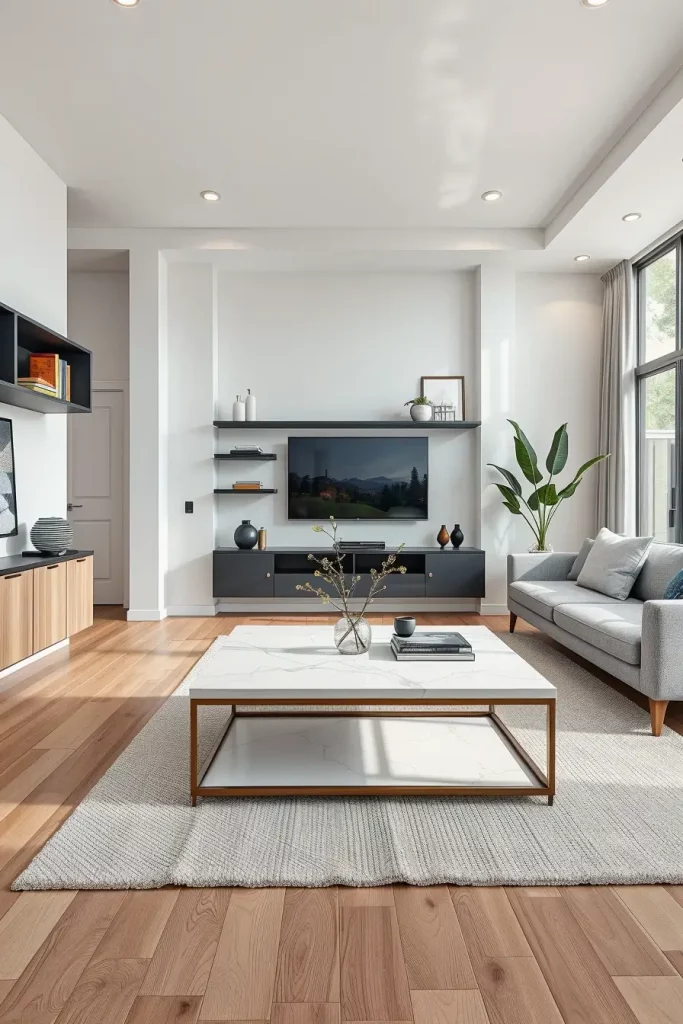
Furnishing features are understated and lack intricate decorations. I regularly keep a neutral color palette with sofa, a slim coffee table, and built-in wall shelving. These furnishings have a light footprint. I select finishes with brass accents in matte black metal, natural oak, and white quartz to elevate the room’s feel. The space feels designed but still has a rich breathability.
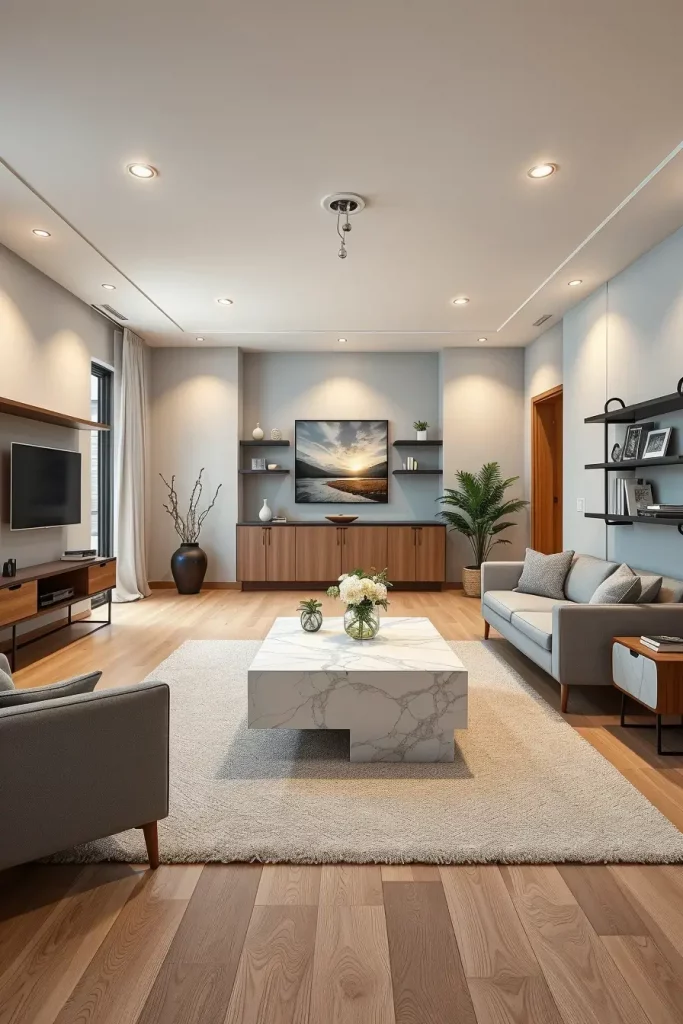
In my own projects, I prefer layering cashmere throw blankets, soft warm fabrics, and wool area rugs along with gentle lighting. That creates added depth without overwhelming visuals. According to Architectural Digest, modern minimalism focuses on clarity and simplicity. Those are essentials in today’s overstimulated environment.
To enhance this part of the section further, I would add a recessed media console or a streamlined TV set into the wall that blends into the area. That helps maintain a clean look while still keeping everyday functionality.
Improving Integration With Open Floor Plans
Planning the social flow is necessary when I create open floor plans. These layouts are characteristic of contemporary living room design, integrating various spaces to foster a more expansive and communal atmosphere. Sightlines and natural light contribute to the spacious atmosphere, making each area more welcoming.
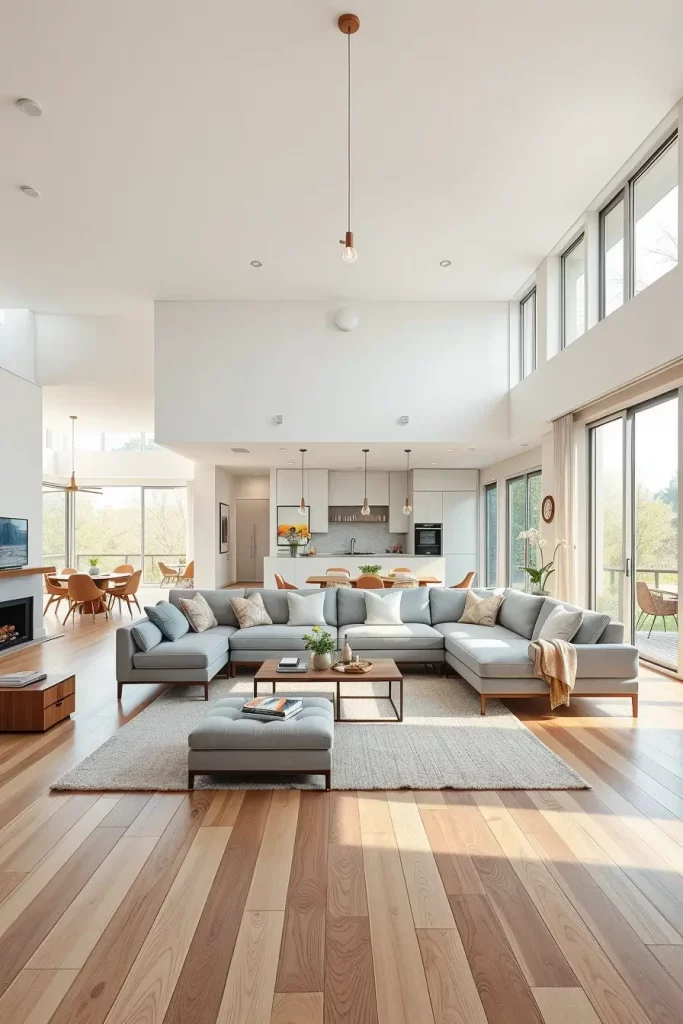
In an open layout, furniture arrangement is key. To achieve unobstructed views while promoting visual separation, I employ modular sectionals or low-back sofas. A neutral area rug placed under the main sofa aids in grounding the living area while remaining harmonious with the adjacent dining or kitchen spaces. Floating equipment arrangements are both functional and flexible.
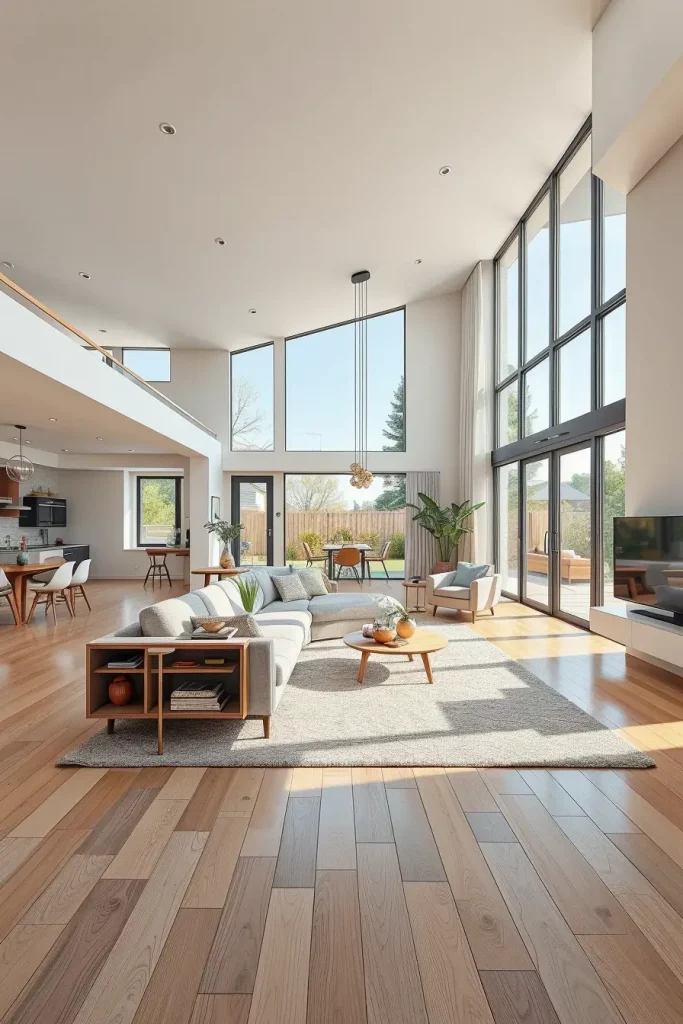
Clients in my experience, appreciate how this layout supports modern living. The layout is particularly advantageous for entertaining, and I always recommend large format floor tiles or engineered wood plank for consistent visual cues across zones. Seamless flooring enhances the break in the formality of the shared areas in open floor plans.
This area would be completed beautifully with pivoting or sliding glass doors connecting the indoor space to an outdoor terrace, further enhancing the flow between indoor and outdoor spaces.
Neutral Color Schemes With Bold Accents
Neutrals are calming, provide balance, and allow bold focal points to shine in contrast. This is exactly how I prefer to approach contemporary living room design.
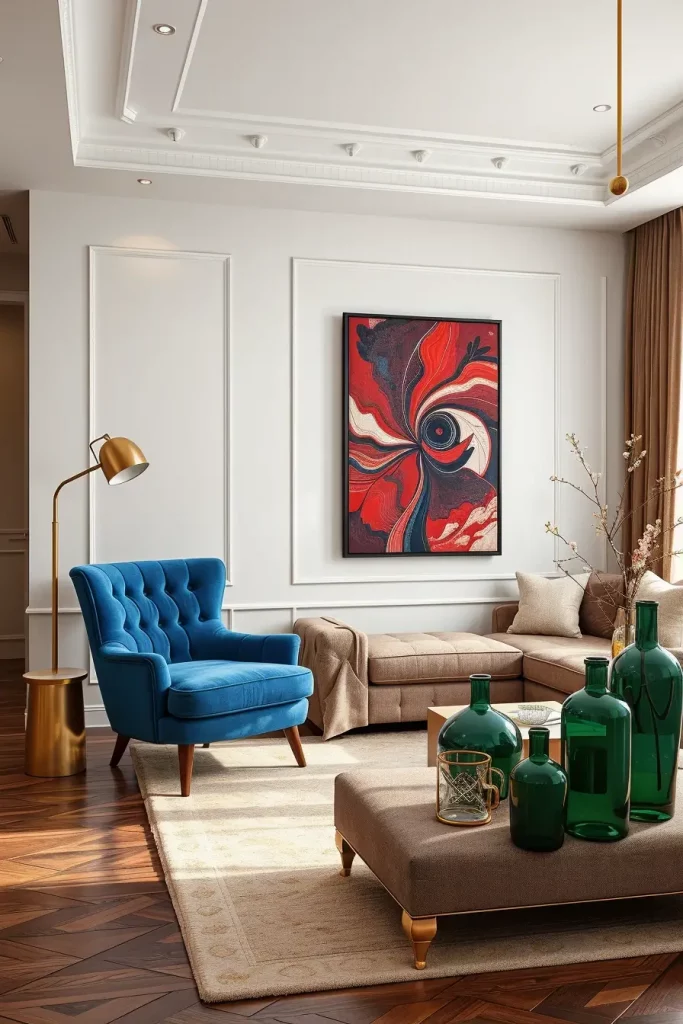
Starting off with calm shades like ivory, stone gray or taupe, accenting the room with decor and art is the last touch to complete the space. For instance, while thinking about cream accent pillows, I can picture a cobalt blue velvet armchair completing the taupe sectional. Deep red abstract paintings or emerald ceramic vases also add life to the space.
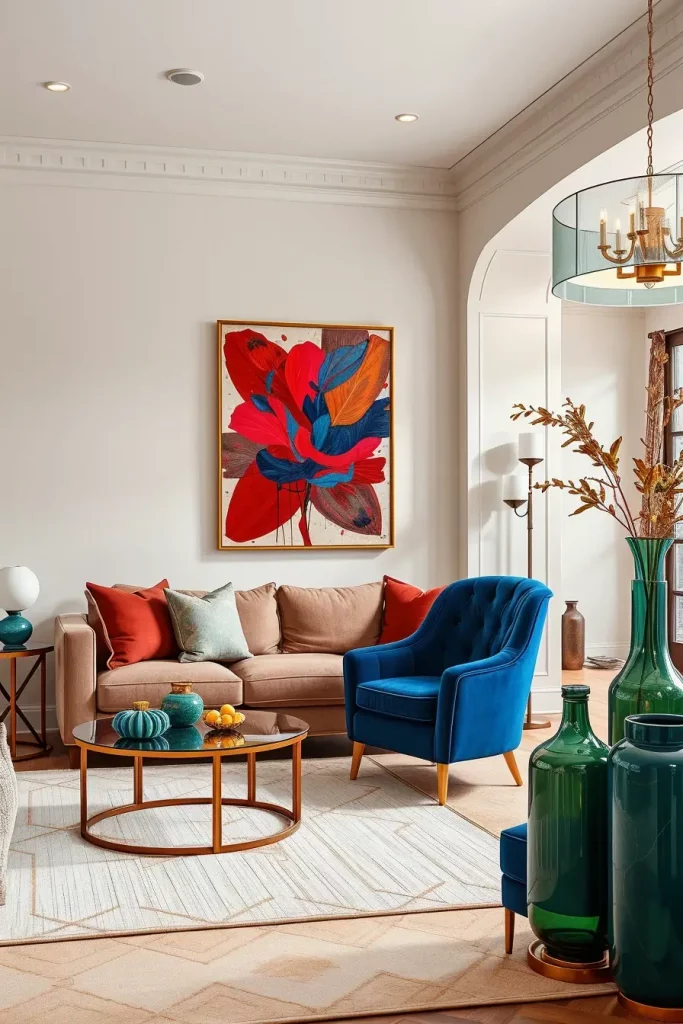
These colors serve as aids, giving enrichening beauty and elegance without flooding or crowding the available space. This technique is refreshing and can be altered easily throughout the year. Changing art pieces around or alternating throw pillows keeps the design feeling dynamic. House Beautiful even goes as far as recommending this approach to people who are after flexibility without committing to a big change.
What’s missing here? To balance the design, I would consider a feature cabinet in bold matte black or a custom-painted accent wall in a deep jewel tone.
Layering Textures For Depth And Warmth
Even in a more neutral color palette, texture breathes life into the living room. To achieve inviting and interesting interiors, I enjoy making use of linen, wool, leather, ribbon, and natural wood. In addition to their aesthetic appeal, textures do an incredible job at softening a sleek space.
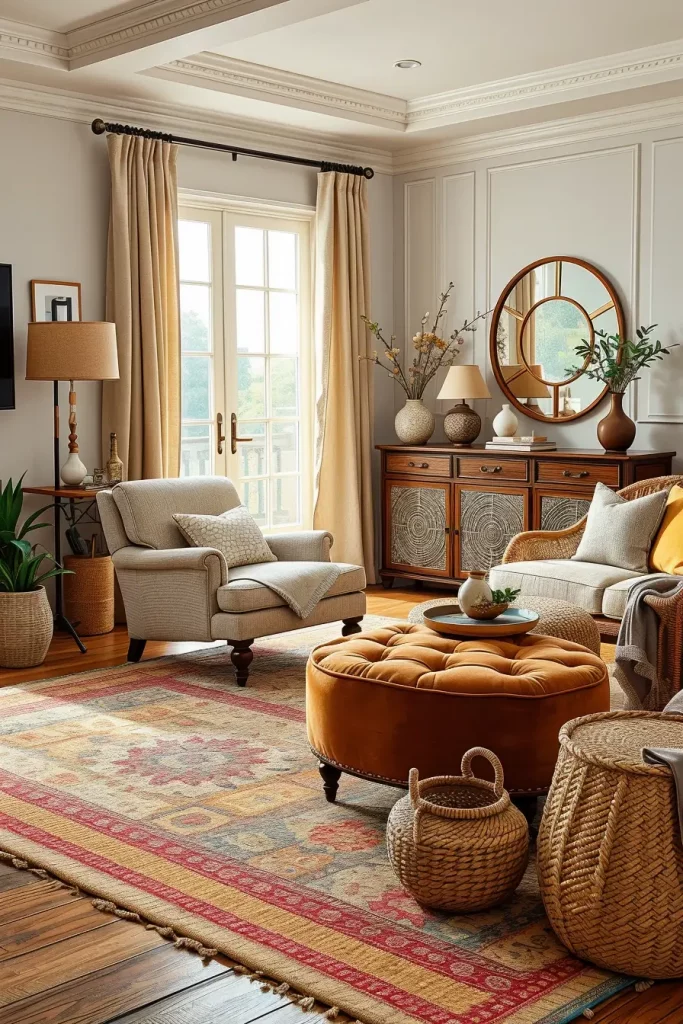
My favorite pieces to work with are open-grain wood cabinetry, ribbed glass or ceramic accessories, and a jute or wool-blend rug. To finish it all off, I like to add soft furnishings in tactile fabrics, and even a soft suede ottoman which adds an intimate inviting touch to the decor.
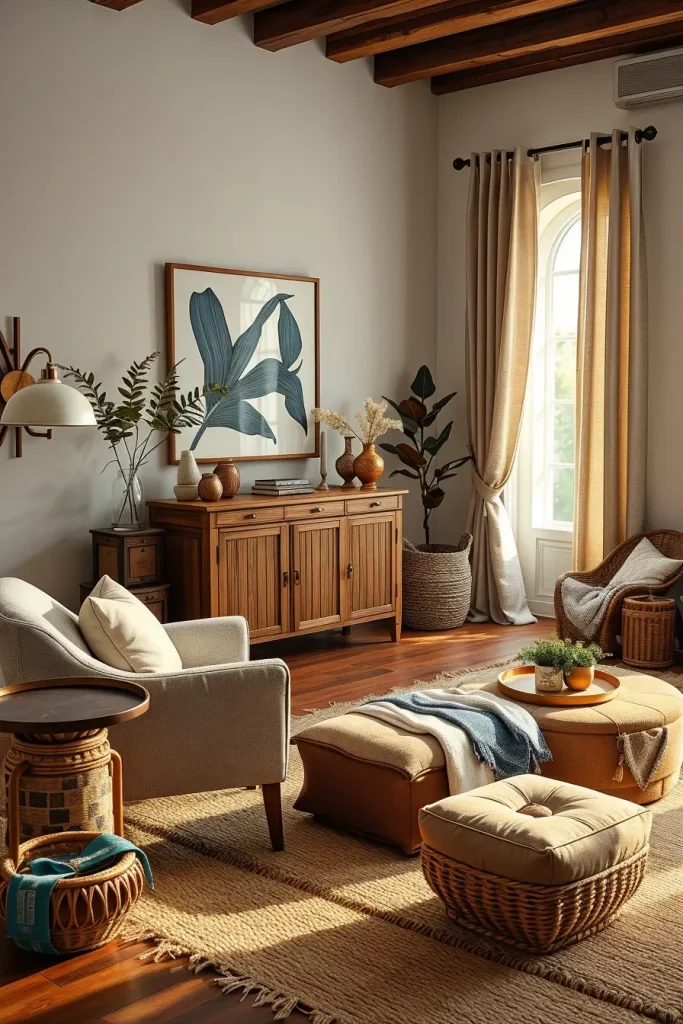
In my opinion texture should be applied in layers. Starting from the biggest elements like upholstery and rugs, then fine the details, finishing with woven baskets or carved wooden trays. This layering approach is often highlighted by Dwell Magazine as key to elevating minimal spaces.
I would suggest incorporating fluted wood panels behind the TV for additional texture on vertical surfaces to complete the section. If combined with wall mounted felt panels, these additions can enhance the acoustics and soften the visual field.
Sleek Furniture With Clean Lines
Streamlined, low-profile furniture fits perfectly into contemporary spaces. My ideal pieces are sofas and chairs which lack visual clutter, having slim silhouettes and simple geometry devoid of rolled arms, tufted cushions, or any extraneous ornamentation. Each piece should be aesthetically pleasing and functional.
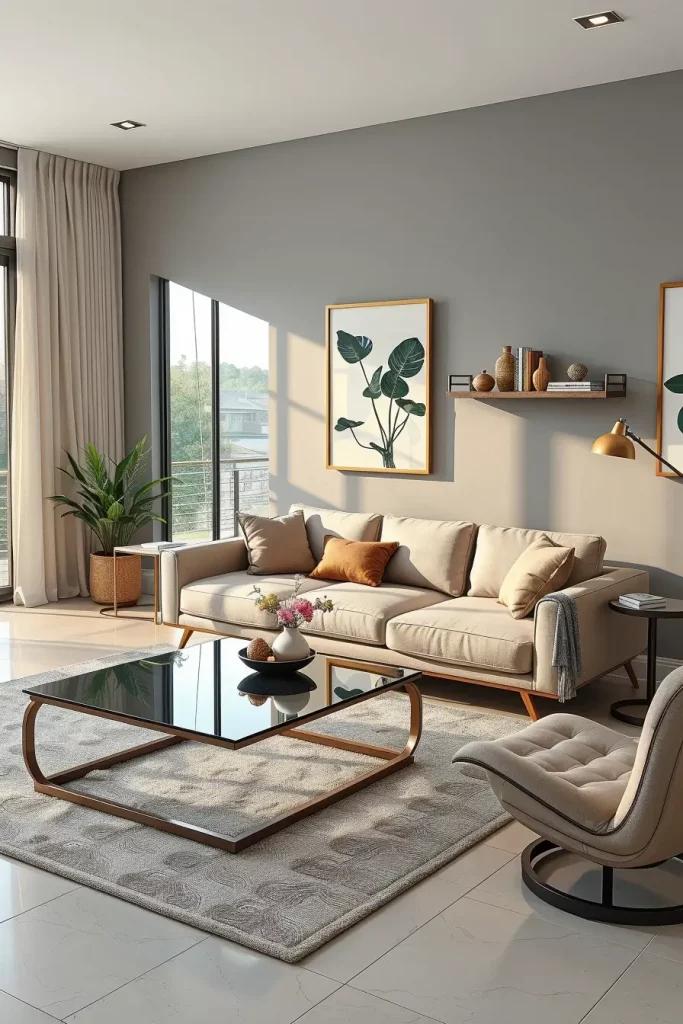
An elegant and grounded look is observed with a neutral textured fabric sofa and a glass and metal rectangular coffee table. To not overcrowd the room, shelving systems and armless chairs are used. I find that floatning storage units and cantilevered side tables allow me to preserve the lightness of the space and achieve the goal of an airy aesthetic.
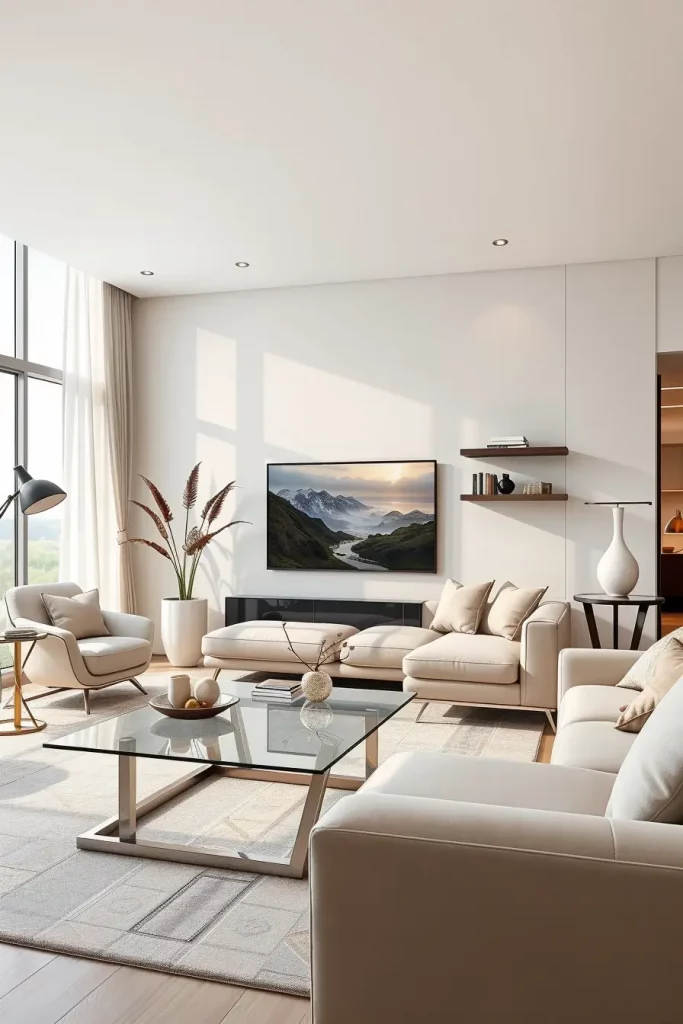
Clients have told me about the unexpected joy they experience from minimalism. This furniture style, according to Domino Magazine, enhances spatial economy within the room whilst also improving flow and focus.
Some pieces I might add to increase the luxurious aesthetic include a sculptural accent chair or a minimal chaise lounge placed in the corner, which serves to soften the overall look.
How Statement Lighting Fixtures Can Transform A Space
In an interior design context, lighting balance and synergy strategically maximizes the aesthetic of an environment while capturing the functionality of its space. As a rule of thumb, I always recommend having some sort of decorative lighting, may that be a statement chandelier, floor lamp, or a linear LED ceiling light in the living room. Decor and lighting come hand in hand.
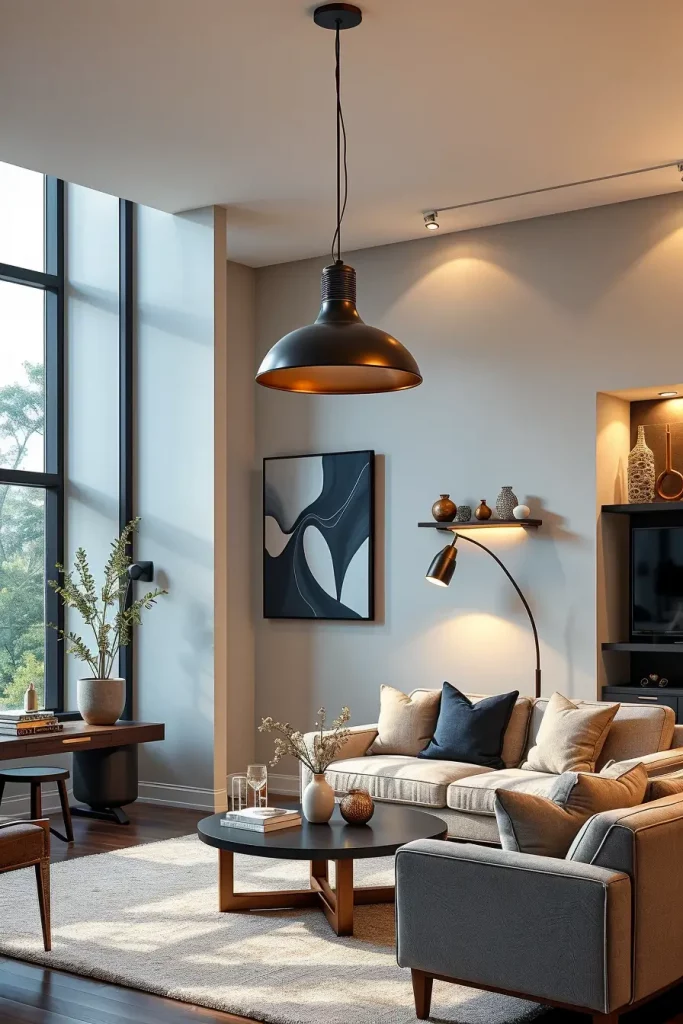
A good example that I can give is a matte black mid-century pendant over the living room coffee table, accompanied with LED wall shelf lights, and a floor lamp. The floor lamp is brass and is intended for reading. There is always the option to dim the lights which enhances the mood and utter enjoyment of the room.
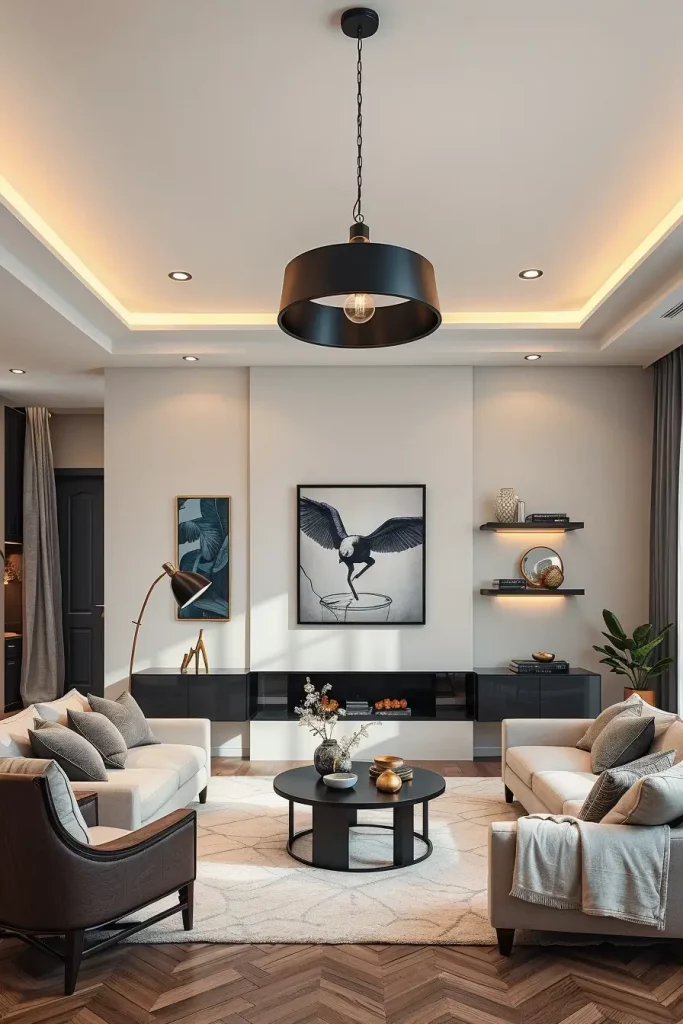
Using unconventional lights can create an eye catching centerpiece for many rooms within a house. As noted in Architectural Digest, using decorative lights can accentuate a room and serve an even more powerful purpose than paintings.
To add on, I would suggest wiring for multiple zones and for optimum manageability adding overhead lights with sconces and indirect lights.
Blending Traditional Elements With Contemporary Styles
A modern living room integrates nature and elegance harmoniously. I, for one, enjoy using rough textures like rattan and raw wood beams and combining them with sleek polished concrete, brushed metal, or lacquered surfaces. It’s this collision that adds depthcharacter to the space.
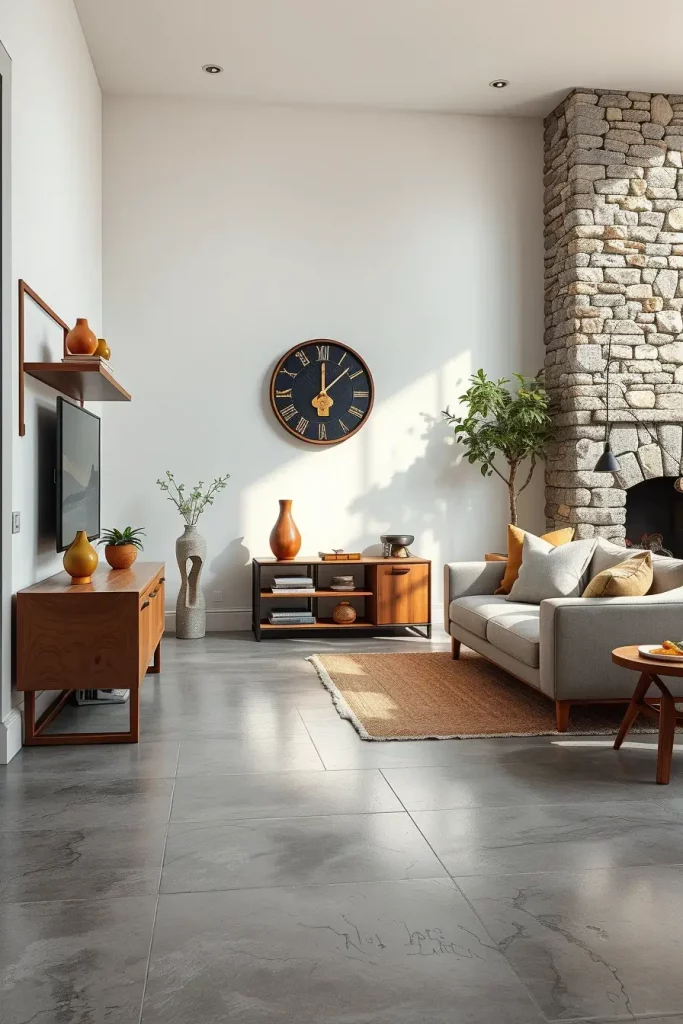
In one of the designs I recently undertook, I paired reclaimed wood media consoles with lacquered coffee tables, linen-upholstered dining chairs, and a matte black metal shelving unit. It felt grounded and elevated at the same time. Natural materials also aid in softening the rigid lines of modern designs, making the space more inviting and relaxed.
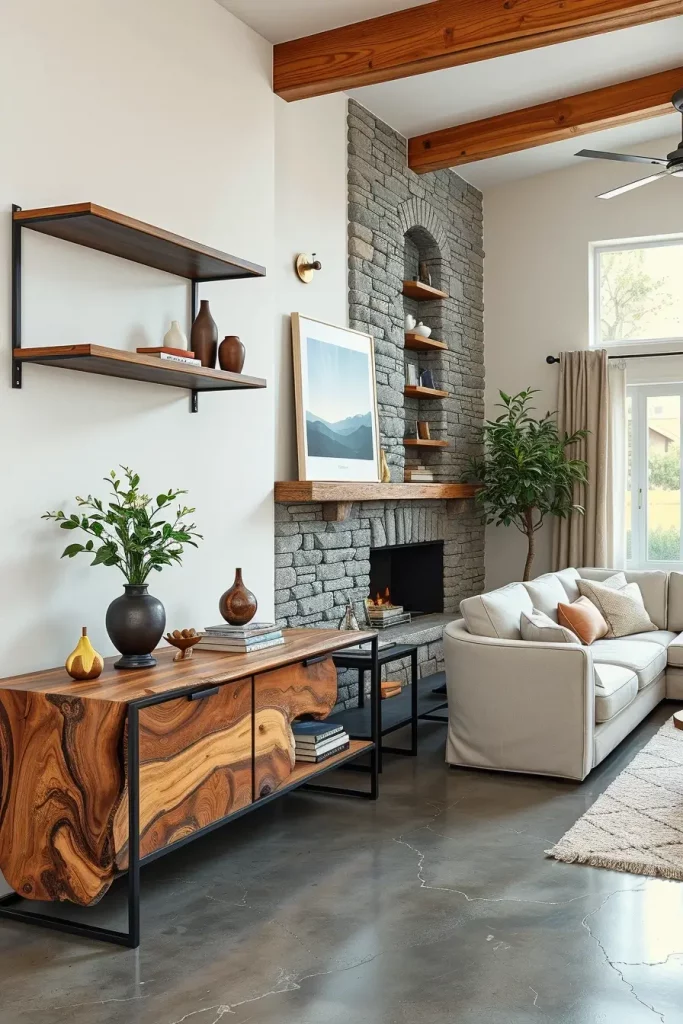
Aesthetically, I always add a few organic elements to the design fex. Fig trees, or even a moss wall art piece, do the trick. Incorporating these biophilic design elements is becoming a staple in contemporary interiors as far as Better Homes & Gardens has confirmed.
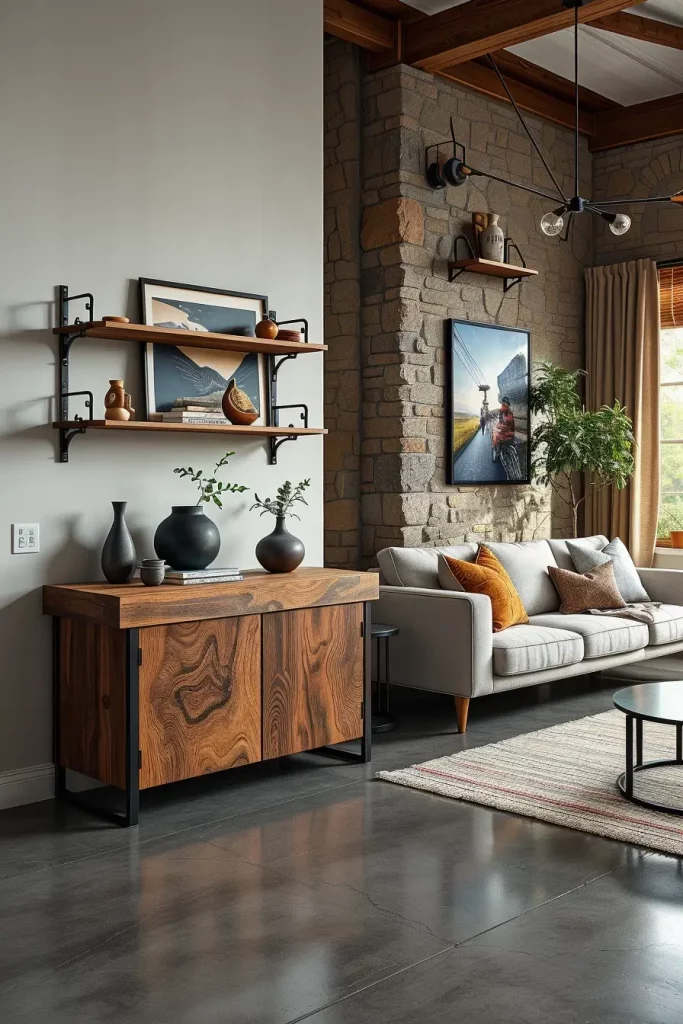
What else would help this section? Maybe a stone clad fireplace or a slate accent wall would further expand the materials palette and help blendmore harmoniously together.
Use of Large Windows And Glass Walls
The design of a contemporary living room can be best achieved by incorporating full glass walls and windows as they open up the house to fresh air and sun. Such architectural features accentuate nature and beauty, makes space feel bigger than it is and highlight framing features, as well as shows the passage of time. In my practice, I use wall-to-wall glazing in almost every room to make the area visually larger, introducing an airy feel.
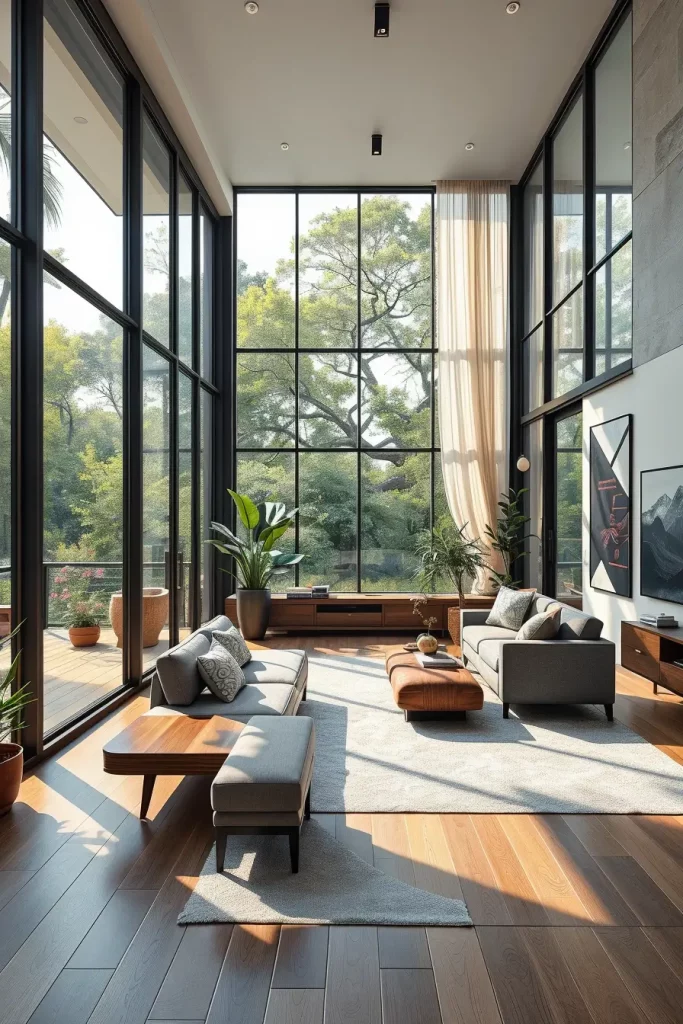
Cabinets and benches are located right next to the opening, so that the view can be enjoyed unhindered courtesy an unobstructed low sectional. Motorized shades or sheer curtains compliments privacy without closing off the space. Beside the window, a sculpted wooden bench provides ample seating without adding too much complexity to the design.
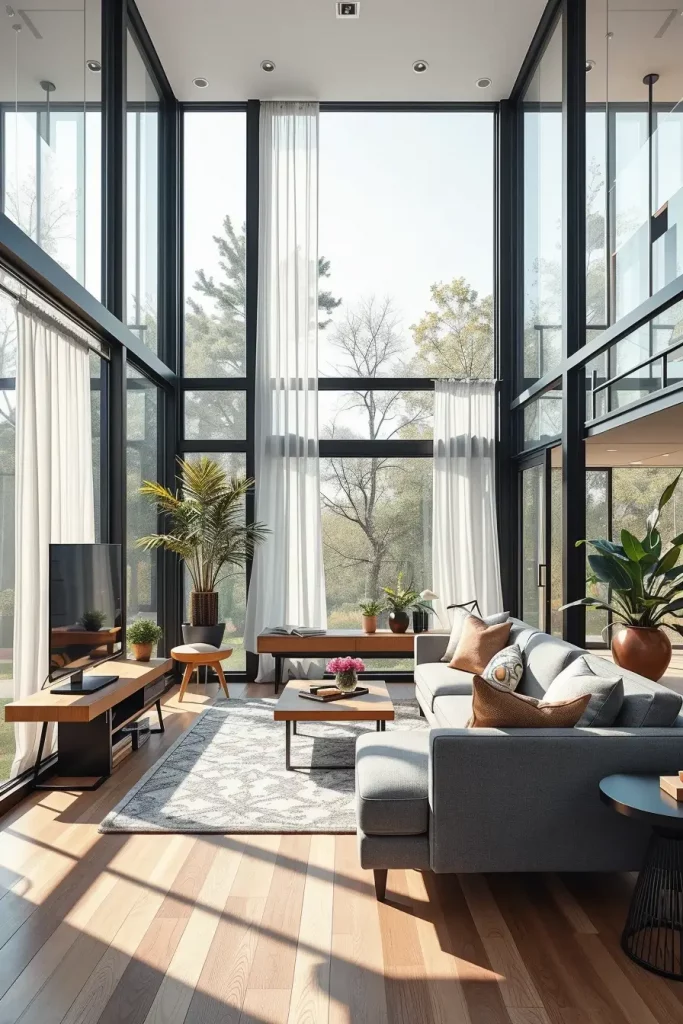
Homes like these use high expansive glass which open up the house nature as well as sunlight, enabling people to wake up with learning and winding down with sunset. It highlights the power of nature of the human psyche and spatial balance, alongside other refreshers of the mind accompanied by rejuvenating design situated in the area. Personally, I love how the soft curtains allows natural light into the home while blocking the intrusive gaze outside. This promotes focused meditation while supporting healthy disconnect.
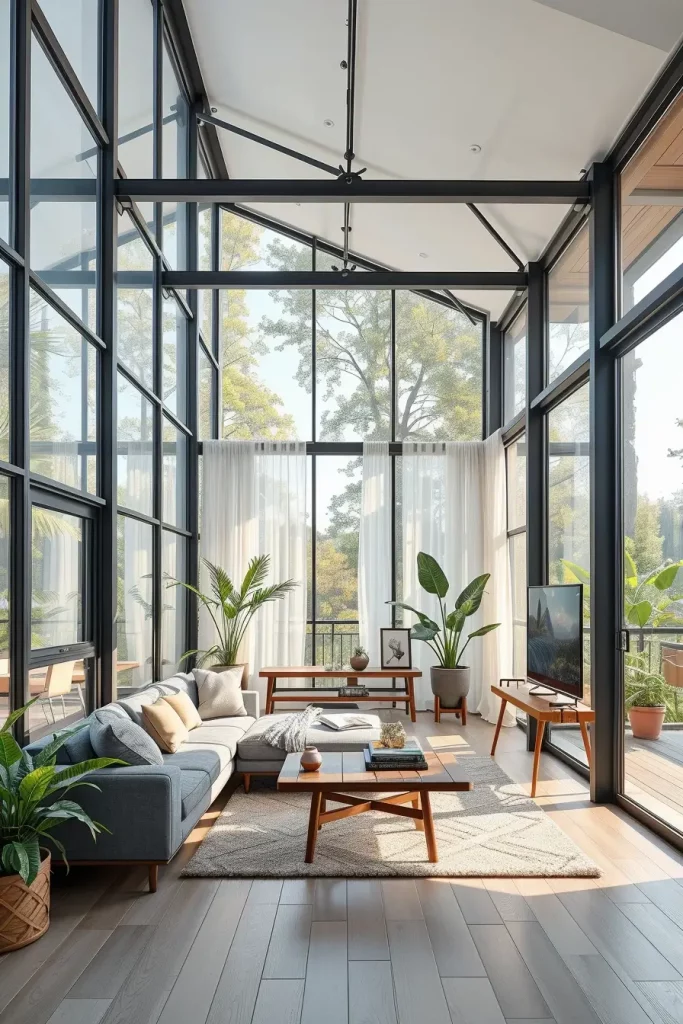
I would recommend enhancing this area by including an indoor plant display by the window or sunken seating that incentivizes guests to look out at the view.
Designing Flexible With Modular Sofas
Flexibility is key when it comes to living room design, and none do it quite like a modular sofa. For clients who prefer to entertain, relax, or work from home, I suggest modular seating that allows them to change the layout of the space. These dynamically designed pieces do not sacrifice beauty for function.
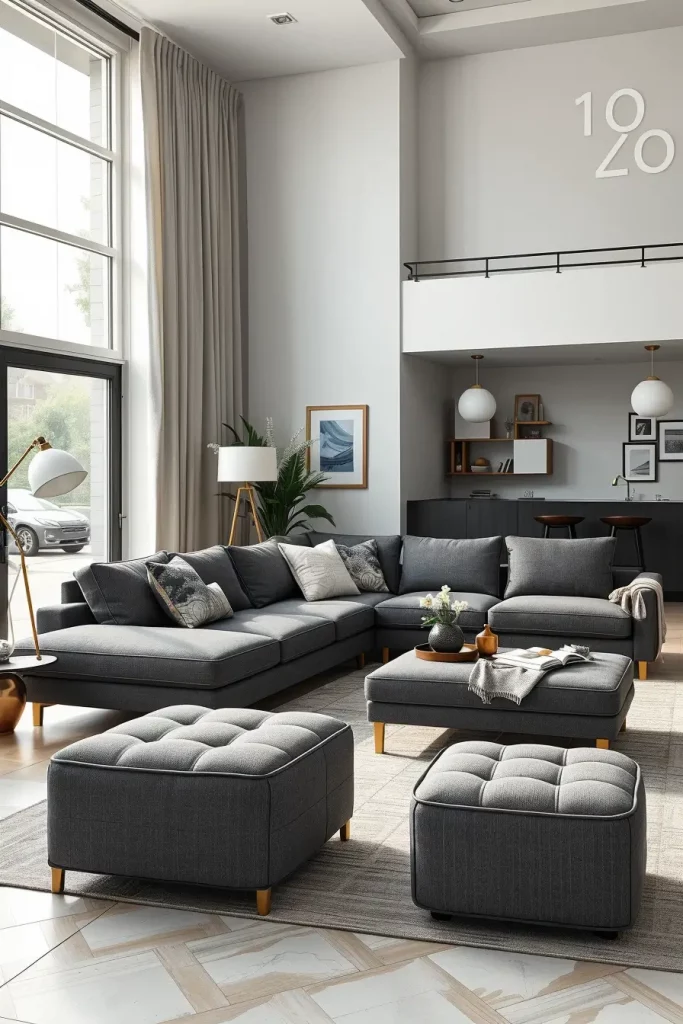
My go to for modular sectionals is neutral tones paired with moveable armless or ottoman pieces. The design allows you to arrange the furniture into a U-shape for social gatherings, a linear arrangement for minimalism, or even separate the pieces into different zones. Modular furniture used velvet or textured weaves to maintain an elevated appearance, without compromising on practicality.
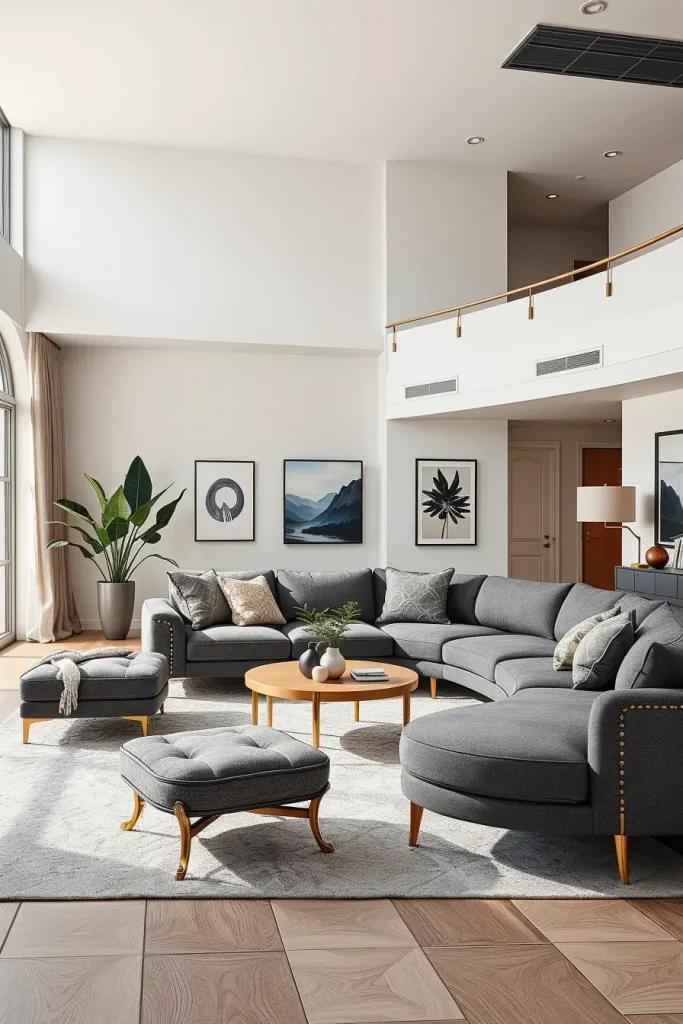
A while back, I designed a space for a couple that wanted a more sophisticated yet family friendly vibe. It gave them the freedom to host game nights, create nooks for reading, or sprawl effortlessly for movie marathons. As Elle Decor puts it, flexibility is modern day luxury.
To increase flexibility of the layout, I’d incorporate a multi-surface coffee table or side tables on casters.
Blending Comfy With Contemporary Style
People tend to think that there is comfort in contemporary design. In fact, the opposite is true; it’s built on livable luxury. Striking the right balance between aesthetic distinction and warmth is my prime objective when designing a contemporary living room. Holistic furnishings and materials truly do make all the difference.
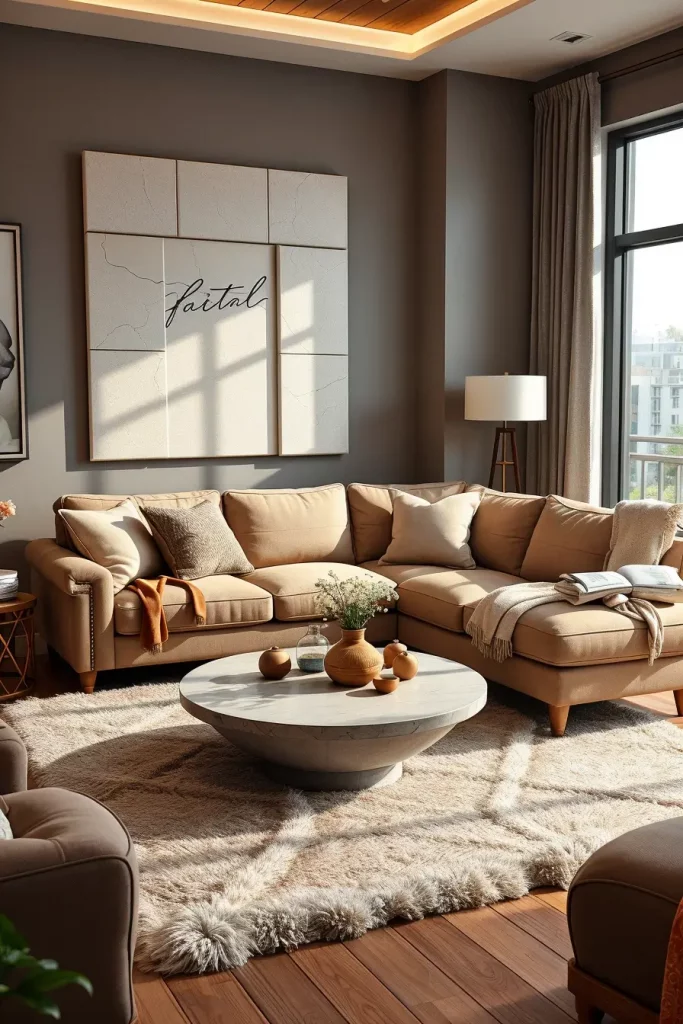
I often use soft sectionals, curved lounge chairs, and layered textiles like mohair throws or boucle pillows. The coziness of the finishes offsets the streamlined silhouettes. A deep-seated sofa, paired with a low-slung coffee table and oversized ottomans, truly encourages lingering. I love to finish the space with soft lighting—dimmable sconces or LED panel backlighting create a cozy atmosphere.
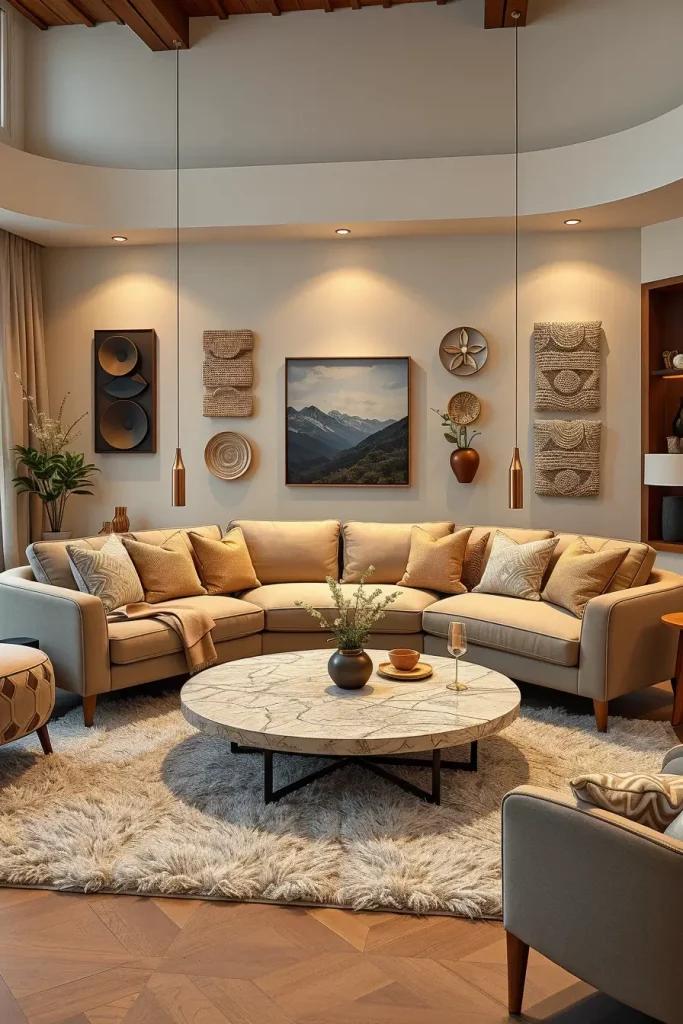
In my home, I paired wall-mounted fabric panels for acoustic control with an oatmeal-colored curved sofa, and a round travertine table. It felt like a gallery, but comfortable enough to nap in. Comfort is the leading driver of modern furniture innovation according to Better Homes & Gardens.
To finish this section, I would include a small reading nook with an armchair, side table, and lamp that can function as quiet zones in a modern area.
Wall Art That Complements The Color Palette
For every contemporary living room, I consider wall art a part of the color story. Art should be in sync with the spatial area while still adding character and storytelling. When curating art, I specifically choose the tone and texture to either complement or not fight with the space’s aesthetics.
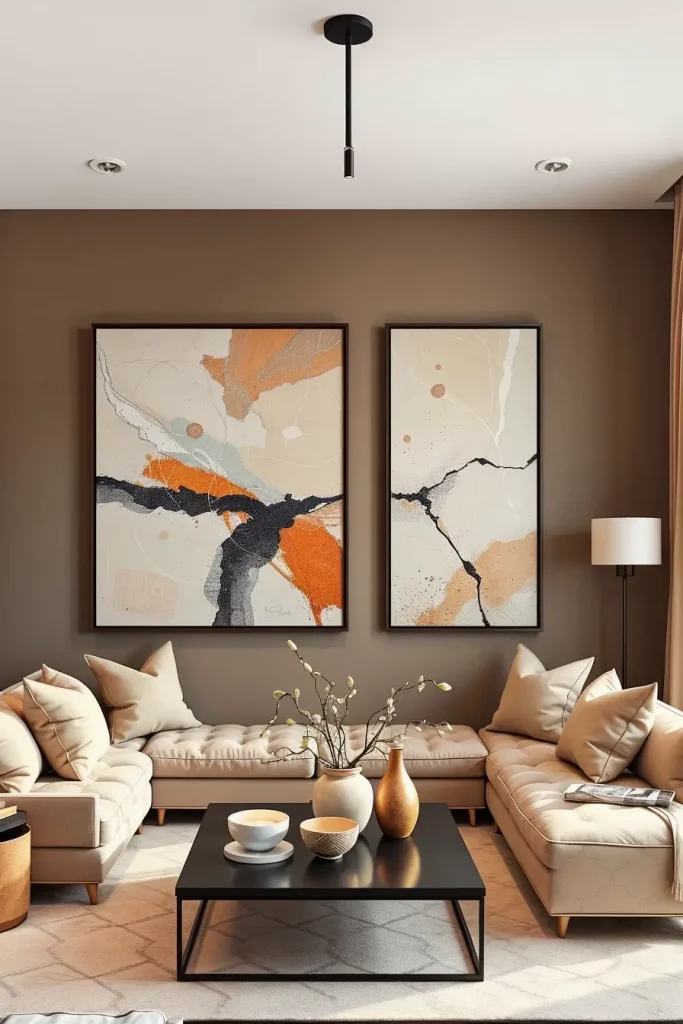
For instance, in a cool-toned room, I might use large-scale monochrome canvases with metallic accents or grayscale prints. In warmer settings, I use abstract art in soft greens, ochre, or rust. I often use slim black or natural wood frames that contrast with the artwork and arrange them in grids or asymmetrically.
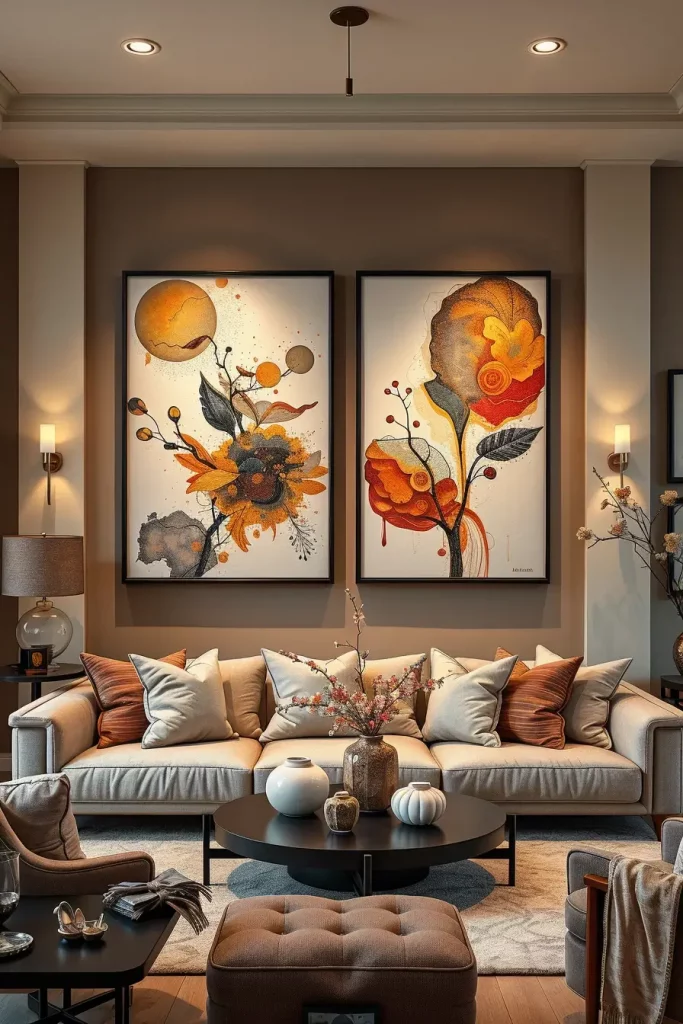
In my experience, this helps ground the space. Once, I styled a room featuring a neutral-toned diptych. I added cushions and ceramics that mirrored the color scheme of the artwork. Dwell Magazine notes that contemporary interiors benefit from subtle cohesion rather than loud contrasts, which often disrupt harmony.
I would place a sculptural wall sconce nearby or even add gallery lighting to the art to better showcase and present the artwork.
Abstract Rugs As A Central Feature
One of my favorite contemporary designs is placing an abstract rug in a place it becomes a focal point. A bold abstract rug not only serves to demarcate the seating area but also provides pattern, color and texture to an otherwise dull room. It serves as ‘art underfoot,’ and what helps to aesthetically pull the space together is why I love incorporating such rugs.
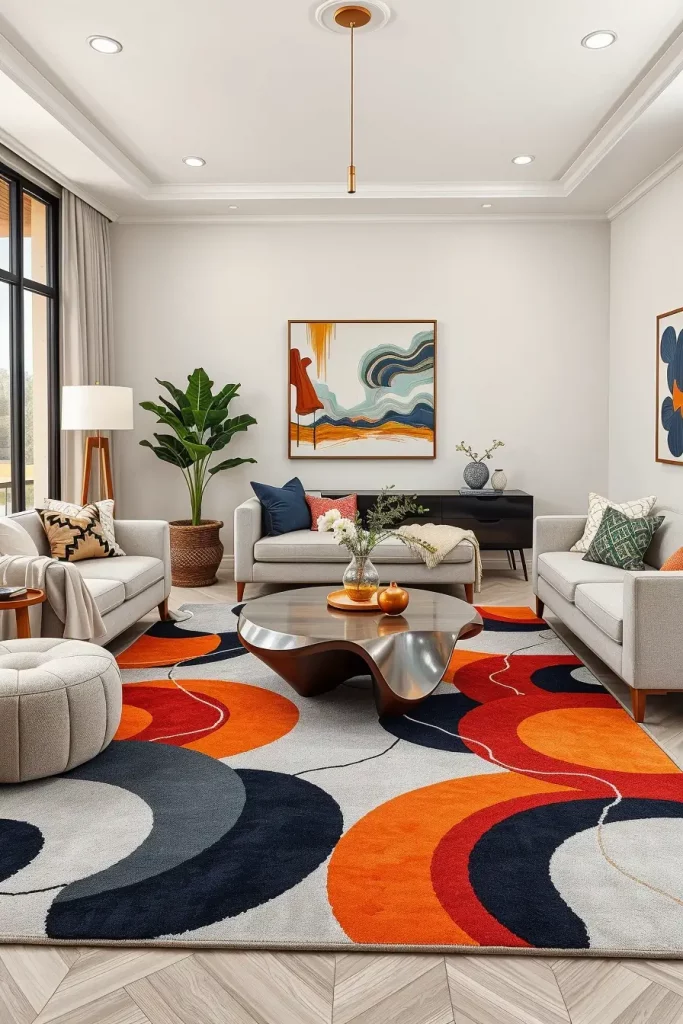
I particularly love hand-tufted wool blend rugs for their comfort and durability. My personal favorites are those with watercolor inspired patterns, tonal waves, or geometric shapes. I usually layer them under a central coffee table, accessoried by sofas or chairs that echo one or two colors within the rug.
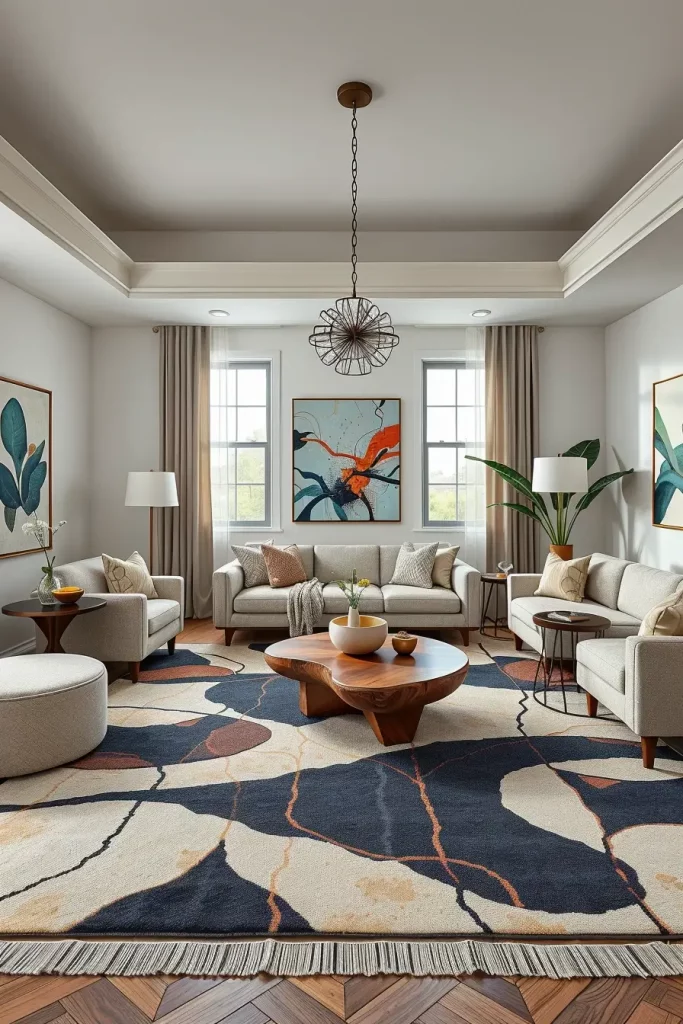
In a penthouse I designed, the entire palette was built off a deep blue and rust abstract rug. My highlight for this project was showcasing how the rug works as a painting, which is beautifully highlighted in House & Garden, showcasing how rugs serve as timeless pieces of artwork and unifying design elements.
For this section, perhaps a round ottoman would complete the look. An ottoman with an organic shaped coffee table would help mimic the pattern while reinforcing the visual role of the rug.
Storage Options That Enhance Appearance
One of the issues with modern living rooms is that they have to be kept neat without encumbering accessibility of the items. This is where the concealed storage comes into play. Often, I implement built-in solutions that keep the aesthetic appeal of the room as minimal as possible while maintaining its functionality.
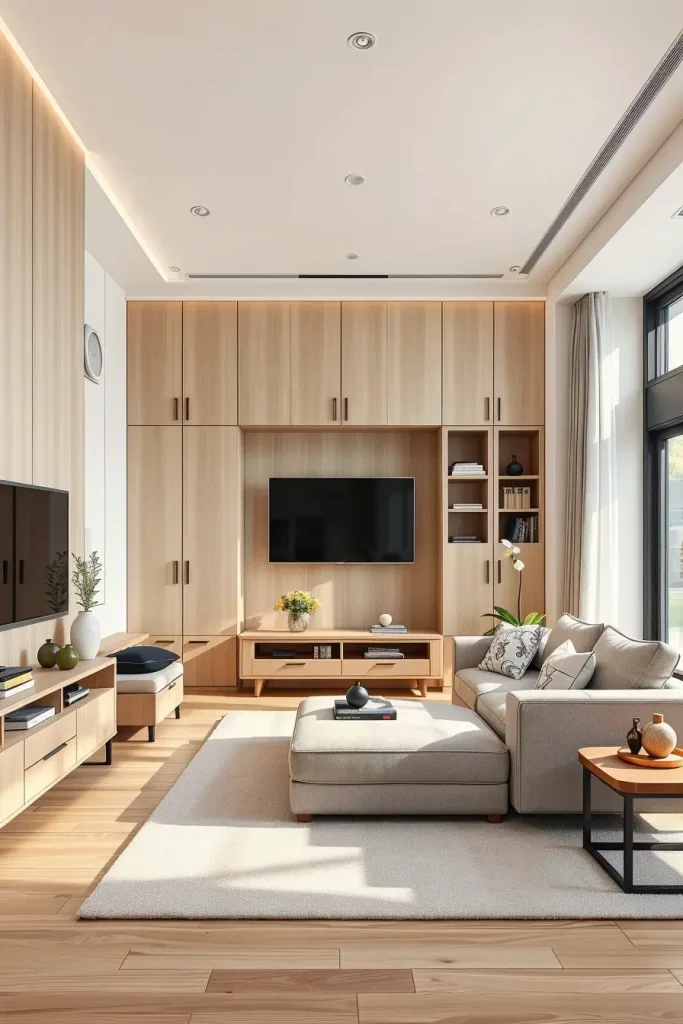
For example, I have push-latch door wall-mounted cabinetry and custom media walls which enable the concealment of cords and remotes. Ottoman coffee tables that have lift tops or hidden drawers beneath sectionals are some of the best in skirted furniture for hiding throws and magazines. Even floating benches and sideboards can possess concealed storage.
They are always amazed at how much storage can be concealed in these pieces. In one of my projects, a slim wall-to-wall console was able to house board games, tech accessories, and books. All of these were kept completely out of sight. As stated by Real Simple, concealed storage techniques continue to be one of the most clever solutions to clutter in a livable home.
For additional honesty and practicality, I suggest using a sliding panel to construct a built-in niche or a bench with deep internal storage that acts as extra seating.
Custom Artistic Curations For Decoration
A contemporary living room is set apart by curated decor. Rather than cluttering the shelves with random popular decor that needs to be thought about, I pay attention to clever and peronsal sculptural pieces that capture attention. Each single object should be purposeful and aesthetically pleasing.
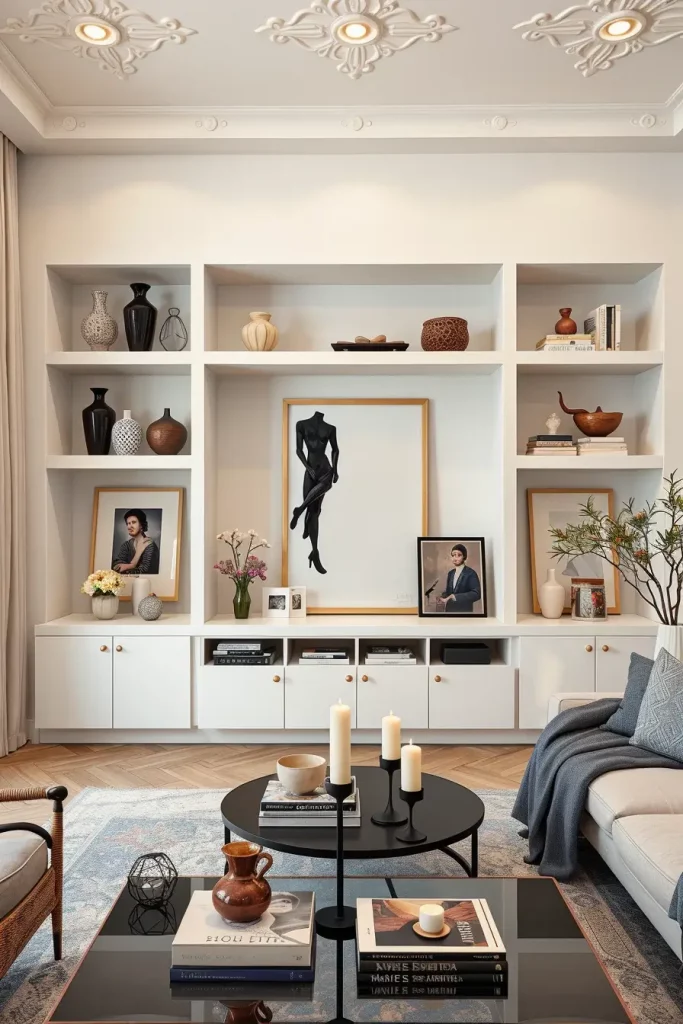
Sculptures, framed sketches, hand made trays, ceramic vases and even metal sculptures serve as my decorative items – all arranged in harmonious clusters. For coffee tables, I prefer high design art books and slim candles, while shelves should feature selective coffee table books with bold gaps in between.
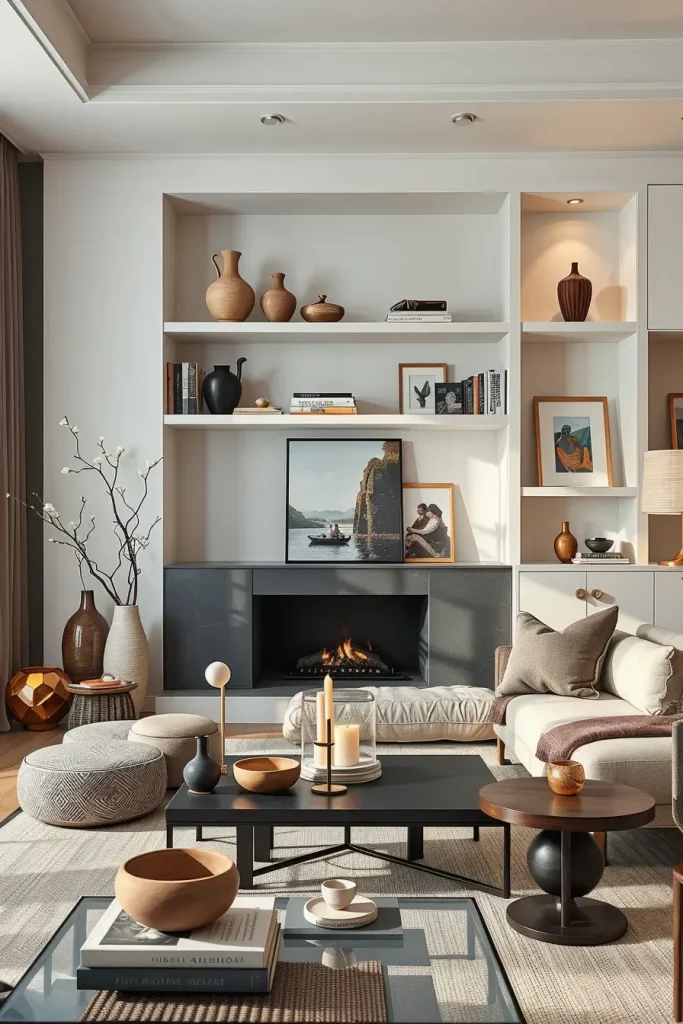
In my own work, I find this approach calm and sophisticated, while still minimalist. It invites sophisticated conversations, which adds to the feel of the room. Adding character to space enhances it, which Architectural Digest recommends adopting fewer character-rich items to clear modern spaces.
For an heirloom sculpture or vase, I would put in a pedestal table with a niche cut out to hint a startling piece of art to round out the idea, along with sculptural centerpiece.
Blending Matte With Glossy Surfaces
In the sophisticated style of a contemporary living room, the juxtaposition of matte and glossy finishes creates a powerful interplay of light, texture, and tone. I have implemented this combination to emphasize negative space that is otherwise neutral. It is incredibly effective for creating a lot of interest without bold color. A matte wall finish provides a solid base, while elements like lacquered cabinets and reflective coffee tables glossy surfaces increase light reflection and openness within the space.
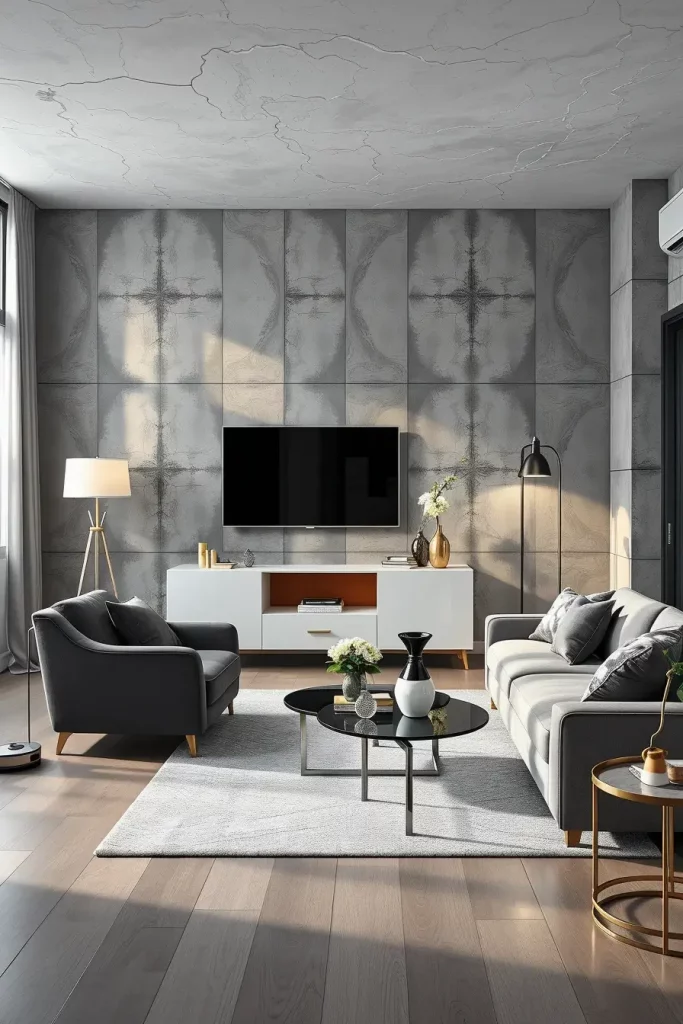
As for the combination of surfaces, I would suggest high gloss furniture like a white lacquered media console or a polished black side table paired with matte-painted walls or concrete textures. A matte velvet sofa can add understated luxury while ceramics or chrome light fixtures help with the gloss. Each finish is effective in a contrast and balance manner. None of them would overwhelm the space, and harmony comes forth.
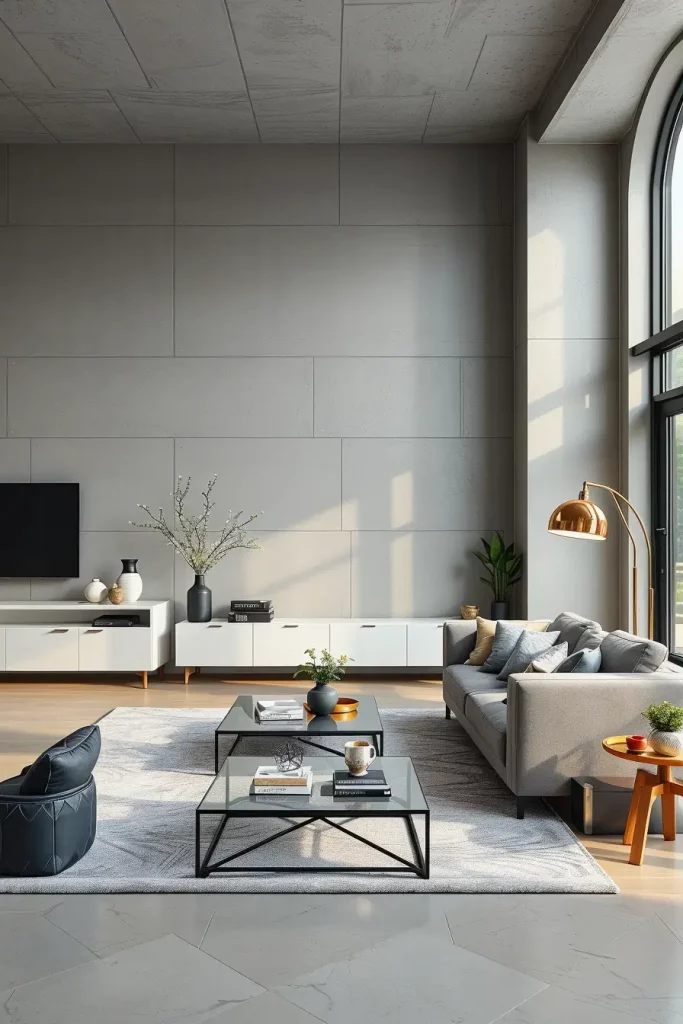
I have found this personal approach especially useful in spaces that require the illusion of depth while they remain uncluttered. This goes hand in hand with advice from Elle Decor, which states that subdued textures combined with sheen, add color richness while providing visual interest and depth. The technique works best for clients with petite spaces which overused can cause overcrowded feeling, yet adds layers.
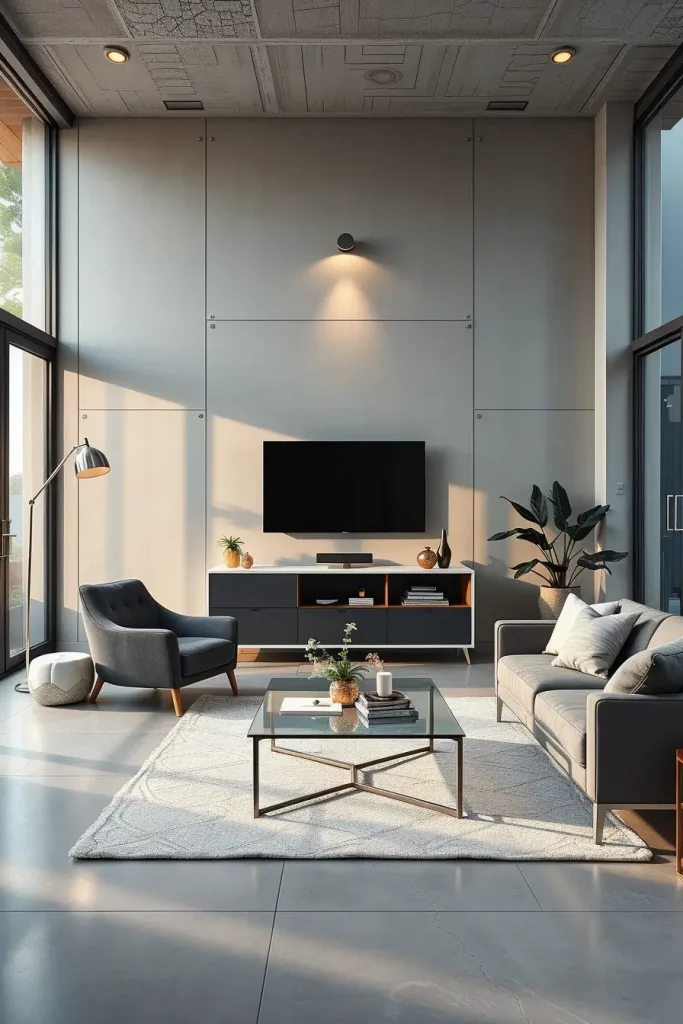
In this section, I would suggest adding some subtle, low-angled lighting that would increase the gloss of the surfaces during the night, as well as incorporating night art pieces that would increase thematic continuity with their polish glass design.
Biophilic Design: Adding Greenery And Light
Bringing the exterior inside is a defining feature of modern living room design. Plants, light, and organic shapes are vital biophilic components. I often incorporate large windows or glass doors into my designs to ensure ample sunlight enters the room, which improves wellbeing while softening some of the severity associated with modern layouts.
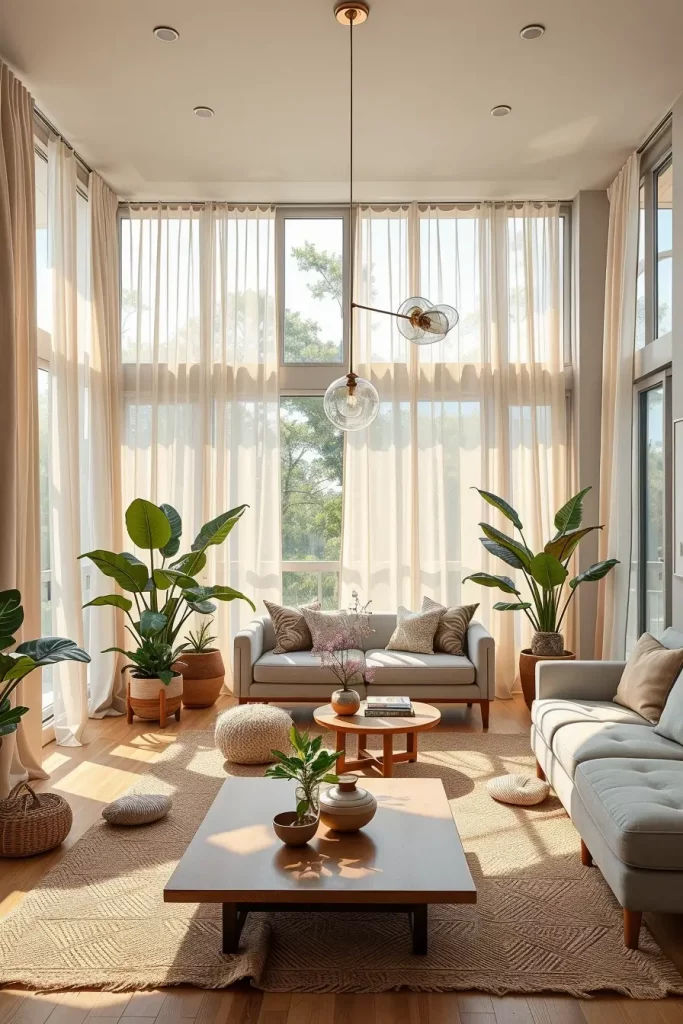
To introduce greenery, I use wall accents made of moss, hanging plants, and fiddle leaf fig trees. Sheer floor-to-ceiling curtains are effective at maximizing natural light and are paired with strategically positioned mirrors. The biophilic look is completed with wooden and stone accessories, while rattan coffee tables, jute rugs, and linen sofas soften the space’s connection to nature.
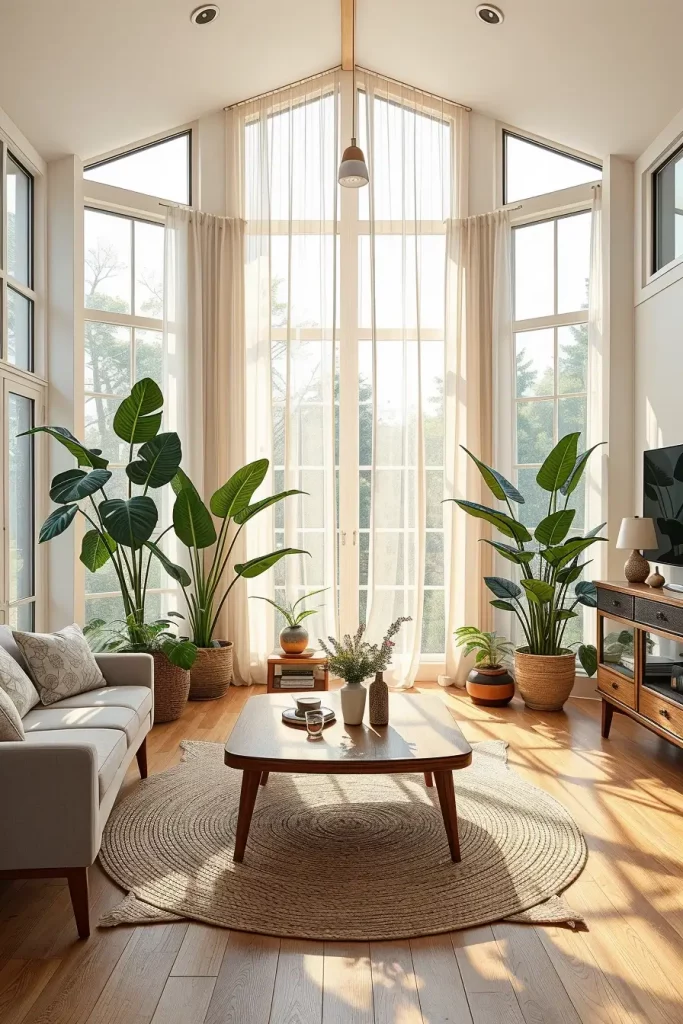
In my experience, clients tend to feel calmer and more focused in spaces incorporating biophilic design. They have also been reported to enjoy improved air quality and hint at enhanced mood. I appreciate how far plants can frame a design while simultaneously adding a sense of life.
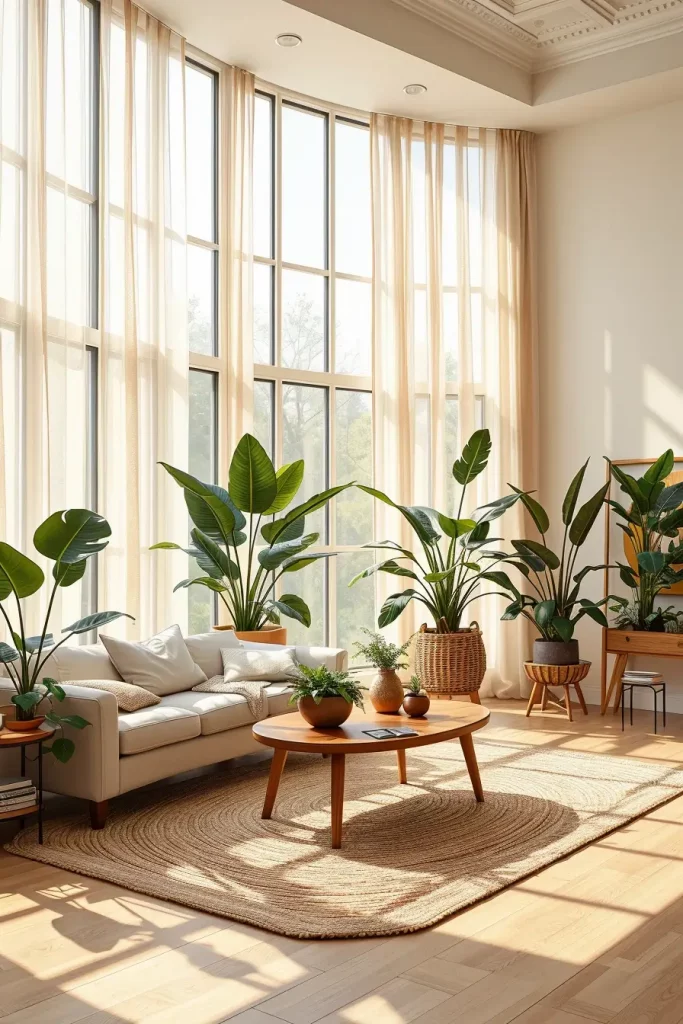
If I were to complete this setup, I’d add a small water feature like a tabletop fountain as it would greatly improve the calm ambiance as well as improve the sensory environment.
Contrasting Monochrome Interiors
Using a single monochrome color does not mean boring or flat, that is in fact, an elegantly sophisticated approach for polishing The Living Room. I frequently employ black, white, and all greys, as they offer depth and shadows. This relies on form more than color and allows the individual design pieces to take the spotlight.
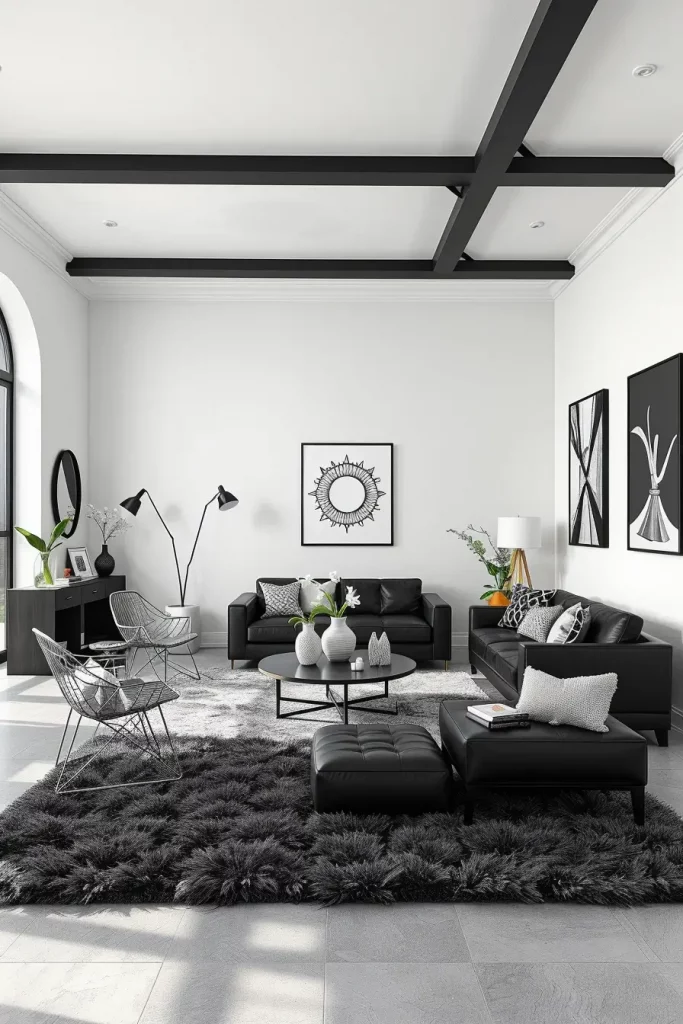
My accent that contrasts this would be a black leather sectional placed against white walls, gray concrete flooring, and metal framed chairs. The result is stark yet welcoming. Rugs aid in defining boundaries, which I use piled high in black and white to anchor the seating area. While black vases or white bookshelves add rhythm without visual clutter, accent pieces do so without noise.
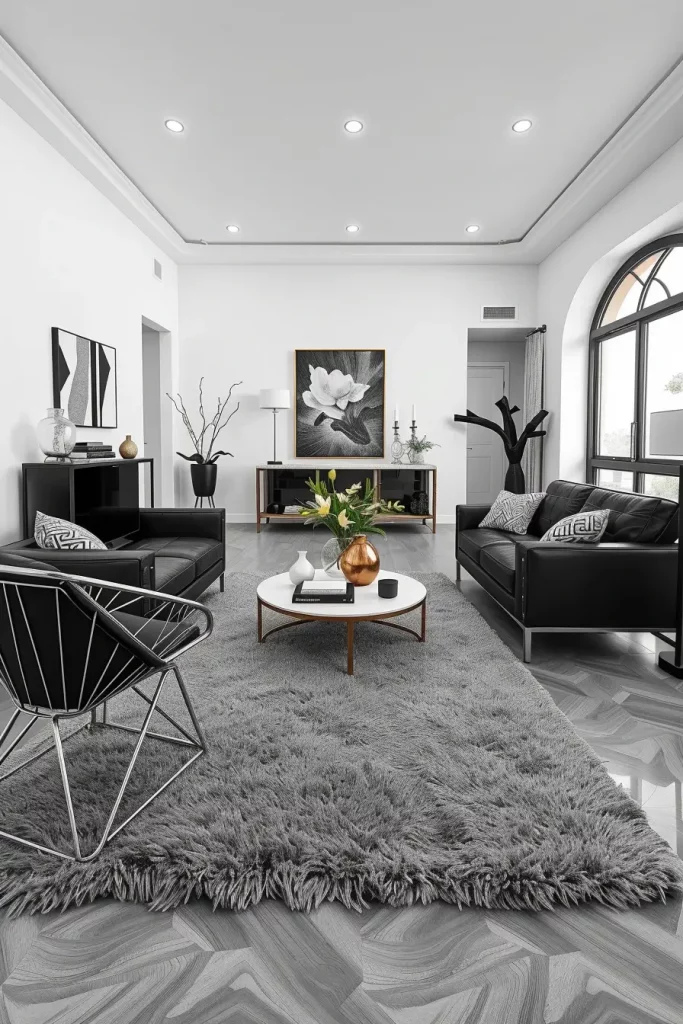
Monochrome spaces are my favorite as they don’t compete with sculptural furniture or artistic lighting for attention. Architectural Digest regularly features the works of various designers in modern interiors, showcasing contrasts instead of colors. These are the moments I appreciate most, when I can focus on the materials used such as marble, glass, or matte steel.
To develop this effect further, I would add depth and hold visual interest to the main wall by incorporating a statement art piece, maybe textured monochrome canvas.
Space Saving Furniture For City Dwellers
Living in a metropolitan area offers the convenience of urban amenities and resources but often comes with limited living space. This is precisely the area where multipurpose furniture can be helpful during modern living room design. In my recent projects, I have sr microwave ovens turning into coffee tables, lift desks, and storage ottomans disguised as sofa beds. It is safe to say all of these options are clever and very appealing choices for modern style.
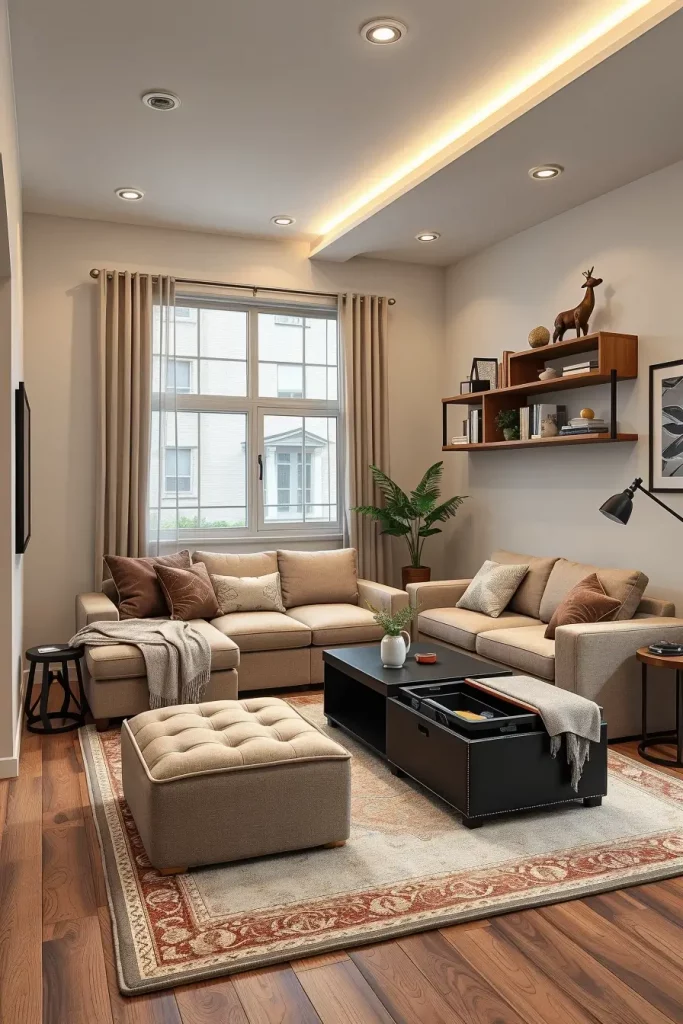
Some of my favorite pieces are indeed sectional sofas which double as storage rooms, writing desks in the form of bookshelves, and coffee tables which can be turned into nested tables. Like other such items, they are usually made using neutral colored fabrics or wood, so they are easy to integrate into any aesthetic. Built-in features such as drawers as bench seats and sideboards with cable control also fit into compact designs.
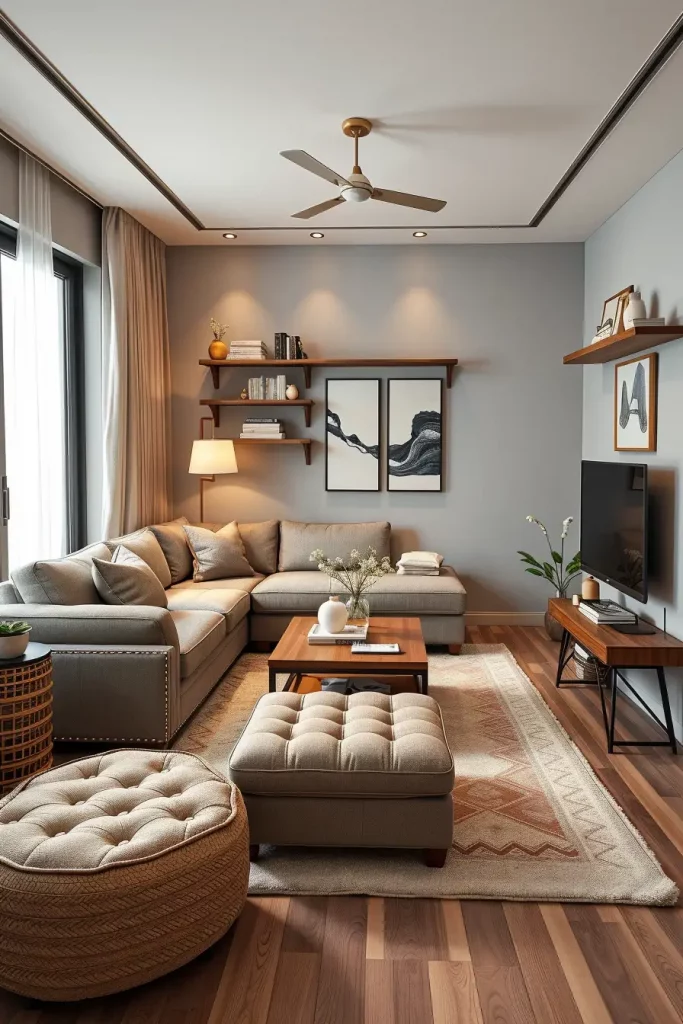
Incorporating these features fosters freedom and flexibility, which is a crucial characteristic when aiming for ease of use. My most recent find is that this is especially true for people dealing with smaller living spaces. This Real Simple article notes multifunctional furniture is one of the most effective strategies for eliminating layout clutter.

As a suggestion to further emphasize this concept, add a custom wall niche for foldable seating or entertainment, which can make the entire room feel different.
Flating Shelves and Media Units
As it is with many modern contemporary houses, floor space is somewhat of a premium and is why wall-mounted media units and floating shelves are must-haves. It intrigues me how they automate the organization of technology and décor without being obtrusive. It also makes cleaning super simplistic.

My set up typically includes a floater console beneath a mounted TV with matching open shelving on one or both sides. Shelves are to complement art books, ceramics or small plants—subordinate, yet important paraphernalia that add personality, without cluttering the space. The items I preferr are Floating Units, which are usually high gloss or matte wood, set in tone with the more prominent pieces of furniture.
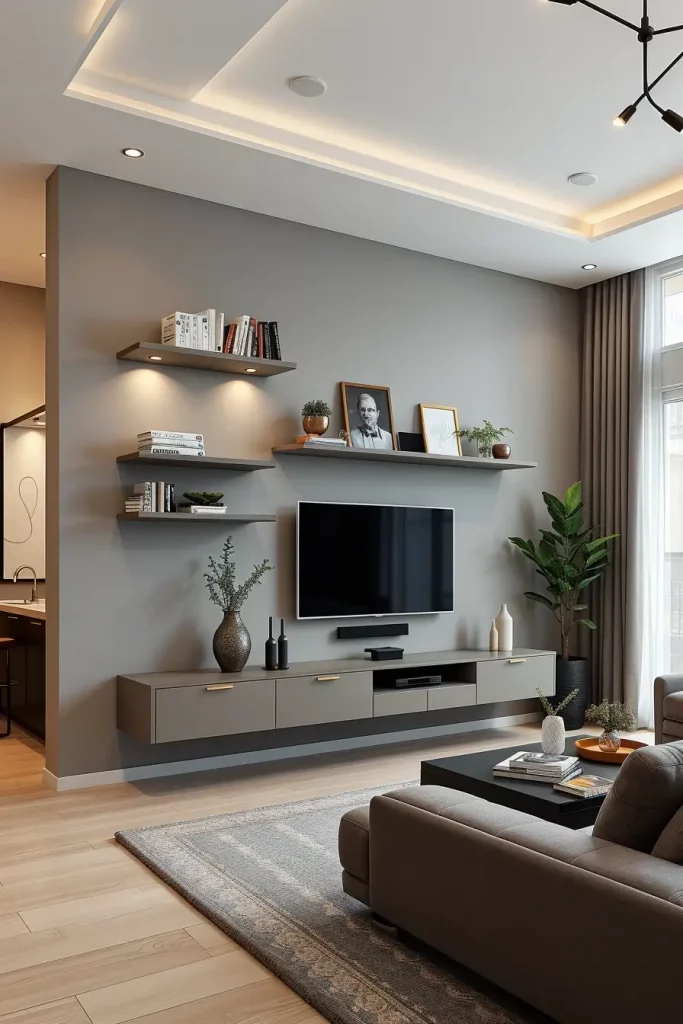
This creates a sleek gallery flow and sleeks frees up floor space. It is precisely these types of wall units that Dwell attributes to the defining characteristics of minimalism, a modern interiors design ethos. For clients who desire simplicity, order, as most would consider, always cake this strategy.
In the evening, hidden LED lights would be required under the shelves to illuminate the décor and further highlight it’s beauty. Form and function at its apex.
Innovative Technology Integration And Smart Features
The configuration of the contemporary living room would be incomplete without the use of integrated technology. From concealed speakers to smart lights and automated blinds, all of them are designed to make life more comfortable. During the initial discussions, I try to understand my customer’s lifestyle preferences and provide technology that integrates seamlessly into their life, but does not dominate the space.

Some of the great tools I use are voice-activated lights, surround sound systems, and thermostats that can be controlled through an application. They simply look more modern than traditional light switches, and that is the reason why I conceal them in wall units and ceiling vaults. Smart TVs that can be turned on more than one way and table tops containing wireless chargers alongside mounted TVs contribute to cleanliness in the room.
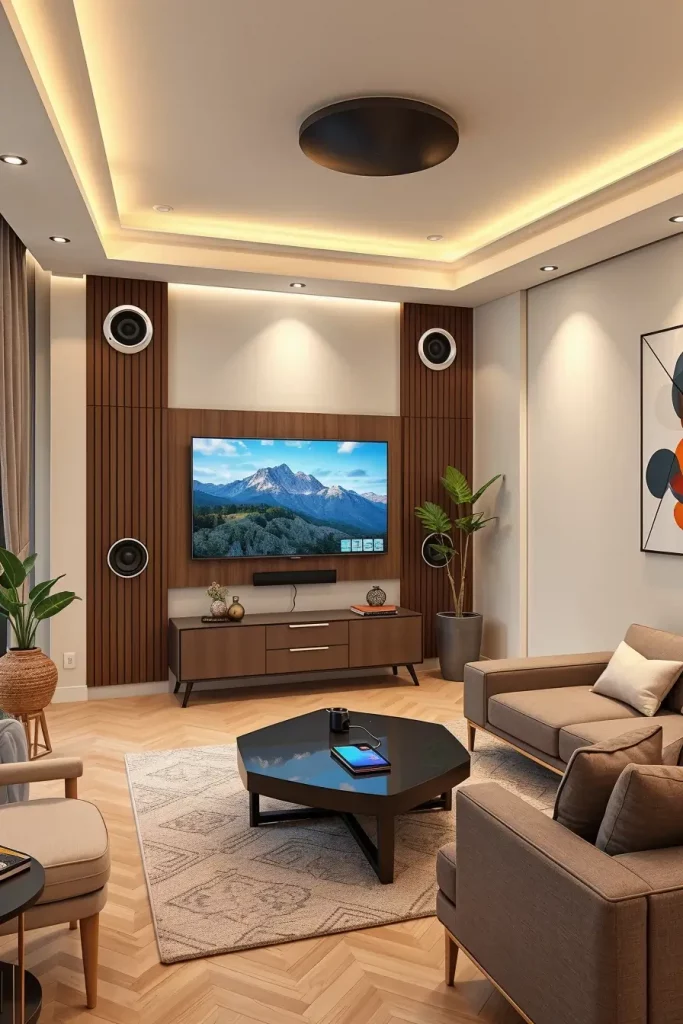
Smart features can be very powerful when executed right. They are simply invisible. It has been noted in Wired Magazine that the rise of “ambient tech” which tends to blend in with the design is increasing. As for myself, I completely relate to that idea. When clients have the chance to interface without strong automation and the interface is intuitive, clients accept automation very quickly.
For the wow factor I intend to emphasize concealed projectors with drop screens for movie nights. Unlike other features, this does not require much space and can add more wow factor to the room.
Creating Light and Space Through Mirrors
In modern interior design, mirrors serve as a longstanding aid in the living room where space and light are dim. For example, a large format mirror or an arrangement of smaller mirrors can increase brightness and create an illusion of spaciousness. I make sure to put mirrors opposite windows or close to other light sources to maximize their effectiveness.
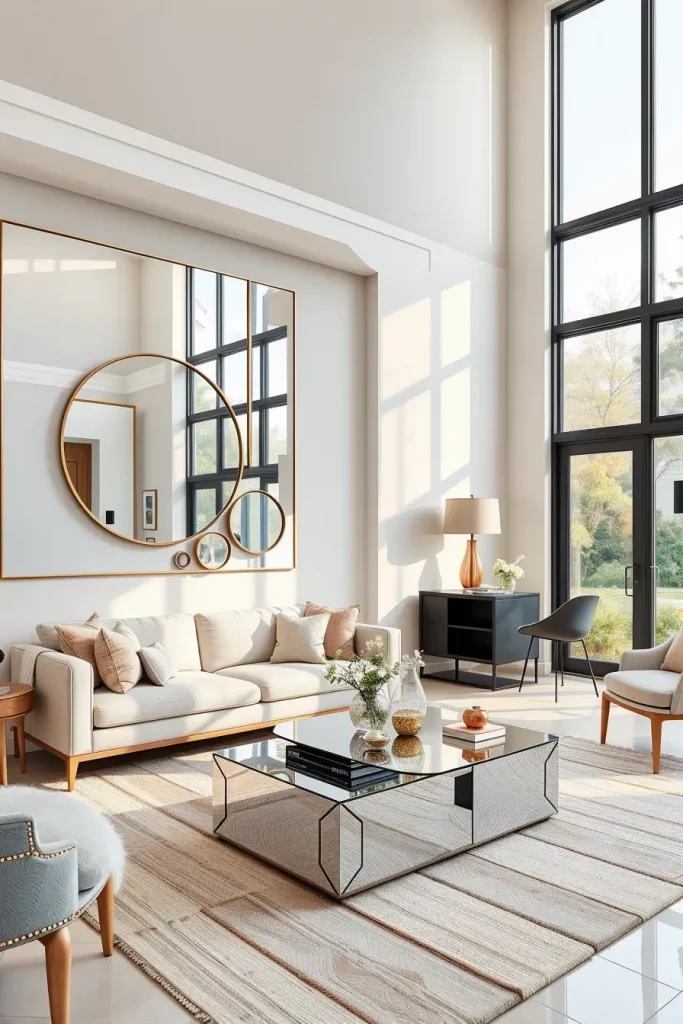
I also enjoy hanging a full-length mirror on the wall behind a console or a sofa. I also decorate walls with round and geometric mirrors. Modern designs look best with frameless styles, but coffee tables made out of mirrors can enhance this style as well. Mirrors and shining elements help capture sunlight which subsequently makes the entire room airy.
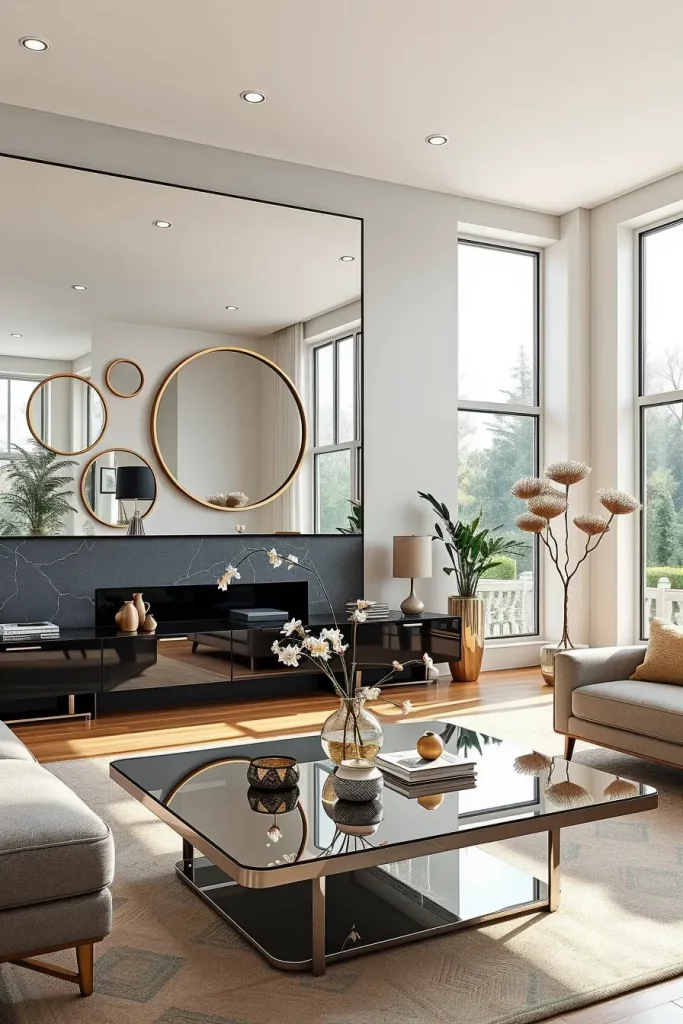
Interior designers like Nate Berkus swear by mirrors and their impact on room aesthetics. Berkus has been quoted emphasizing how proper placement of mirrors can drastically change the look of a room. I have used mirrors in narrow living rooms and they have stretched the perspective and hypnotically eliminate any sense of claustrophobia and the feeling of panic rooms.
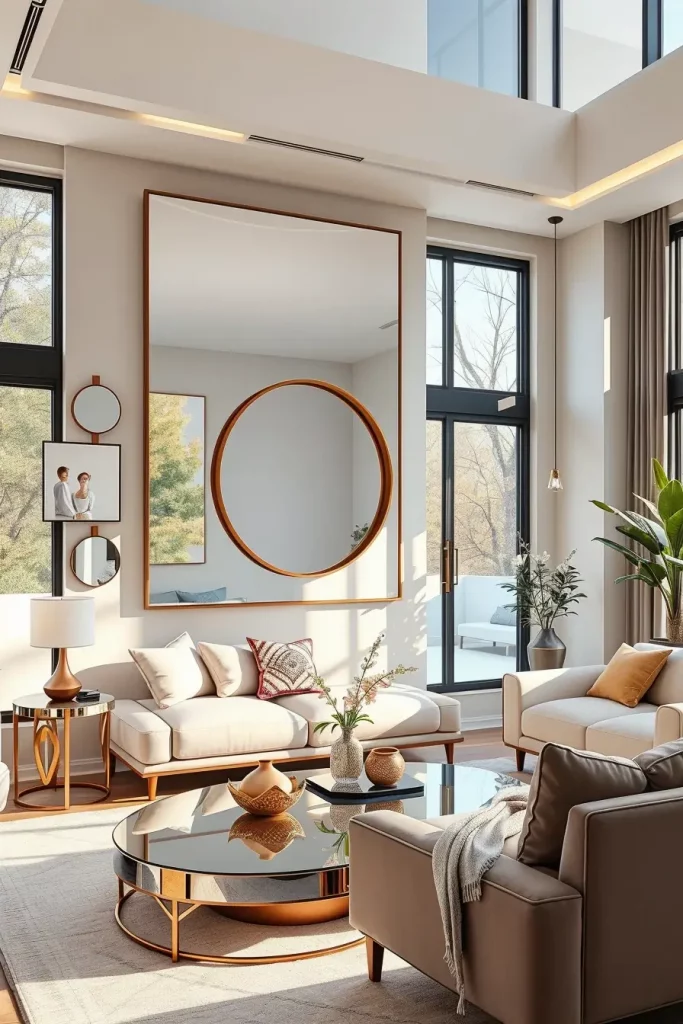
As an ending touch, I would place a bar cart or media unit to add a mirrored panel with the objective of discreetly elevating the class appeal of the room.
Floor-To-Ceiling Curtains For Sophisticated Touch
To soften a modern living room without adding clutter, I often turn to curtains draping from floor to ceiling. This specific style not only adds to the height of the room but also frames the house beautifully whilst adding plushness. Furthermore, it aids in controlling light and privacy, especially in metropolitan areas with big windows.
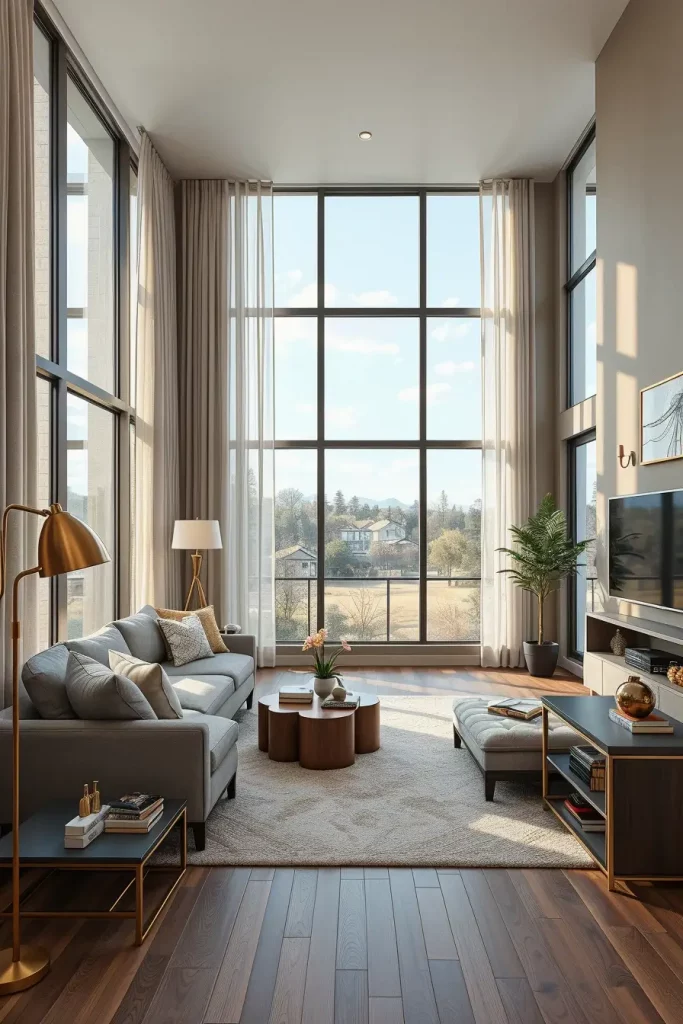
Most of the time I prefer warm gray, ivory, linen and sheer cotton curtains of muted colors, and the rods need to be fixed as high on the wall as possible. The curtains need to stand even when the windows are not so as to create visual coherence. Adjustments with neutral toned furniture alongside contemporary lighting strikes me as sophisticated and complete.
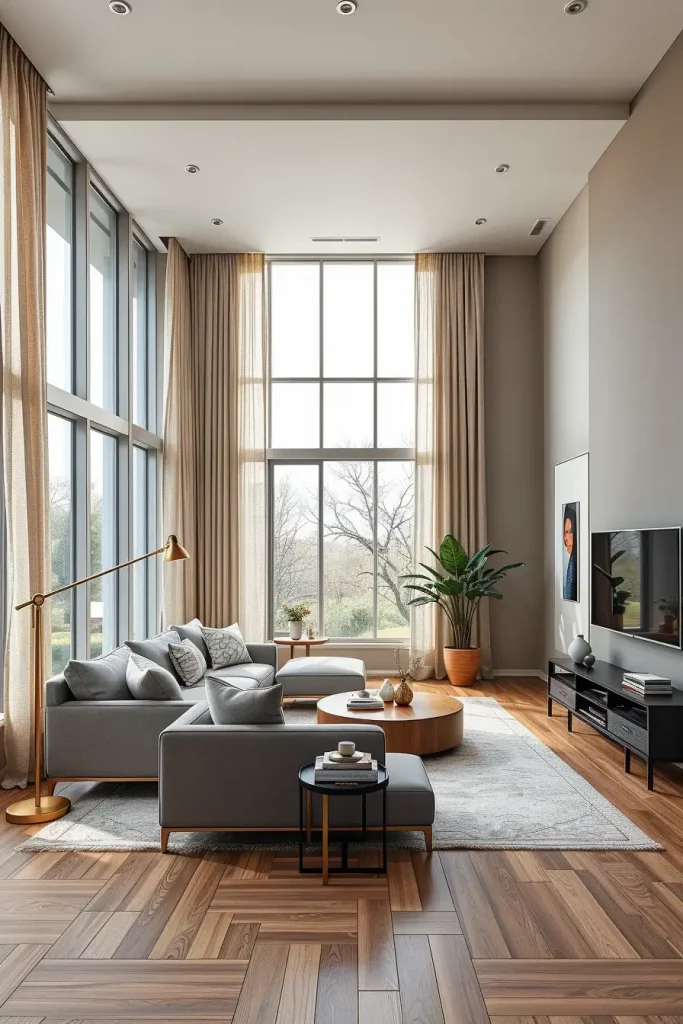
This is one of the approaches many designers featured in Architectural Digest use, and for good reason. In my experience, it lends a softening flow to spaces devoid of clutter and ease of texture without the demand for lavish ornaments, while retaining a touch of modern sophistication.
To make the design even more pleasing to the eyes, track lighting should sit above the curtain rods. This addition allows for the curtain to glow whilst draped in light at night, which is an stunning effect.
Playing With Geometric Shapes And Patterns
Geometry is one of the major features in modern interiors. In my case, it’s energetic geometric rugs, wall art or pillows that I like to use to bring subtle energy into the room. The goal is to encourage movement while not creating pandemonium.
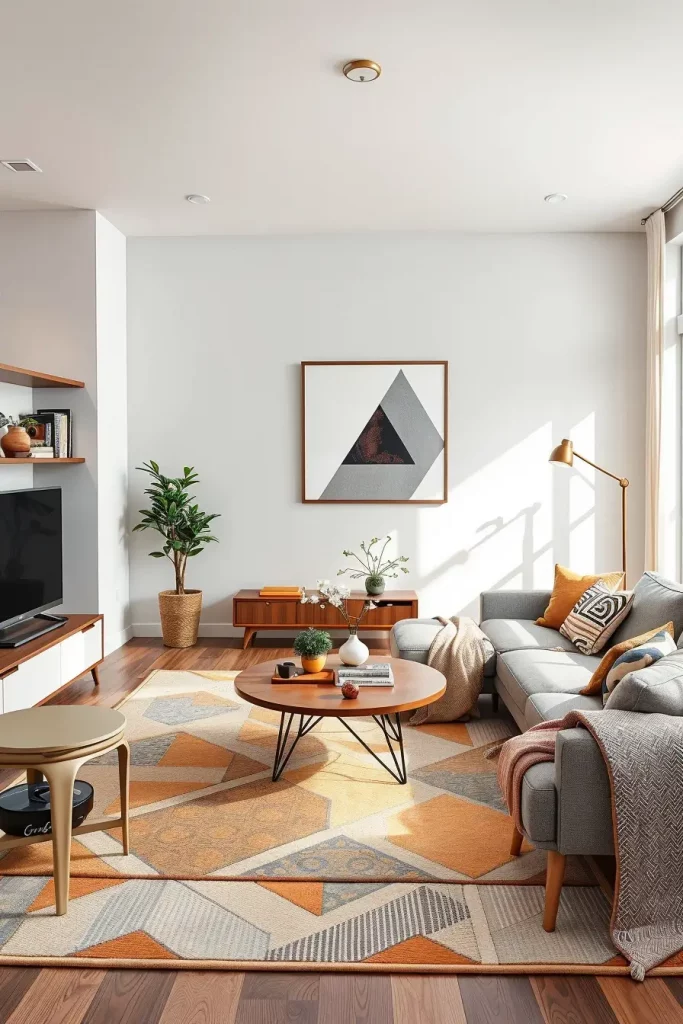
To relax minimalistic designs in living rooms, I usually combine round coffee tables with linear sofas or add angular shelves with triangle motifs blurring the distinction between 2D and 3D. My favorite utilizations of borders are chevron and hexagon on rugs or throw blankets. I sometimes go for bold geometric wall art that helps create focal points. All of these especially help in creating balance with open-concept spaces.
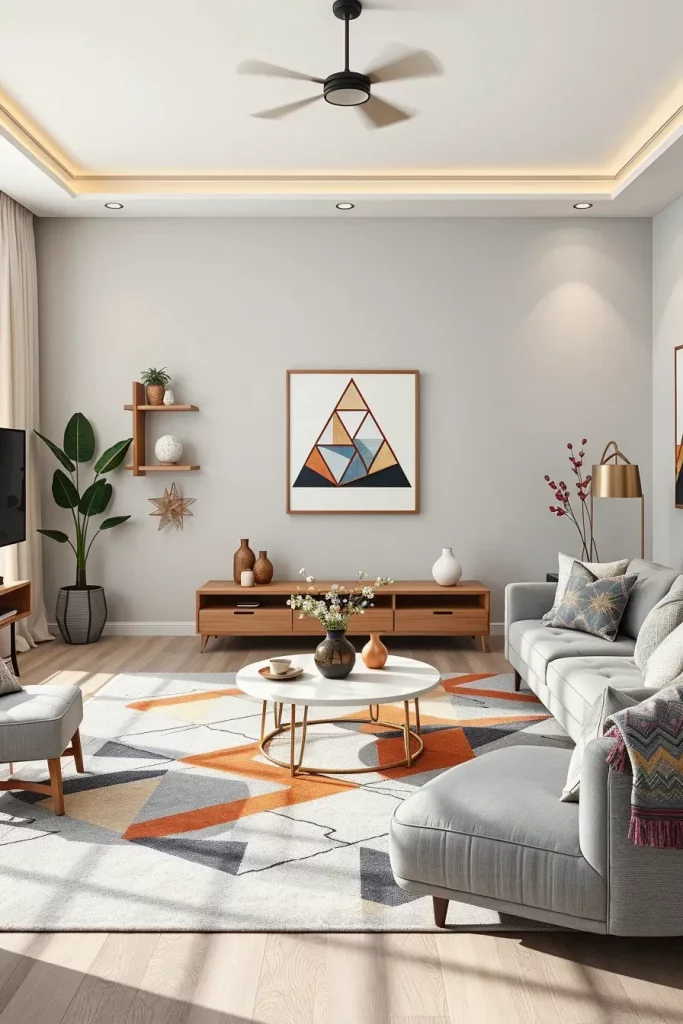
Wearstler is one of the designers that has incorporated geometry in an energetic manner that I vividly remember. While graphic patterns can add depth to modern furniture pieces, her approach to geometry is something that I try to incorporate into every project.
Wondering how to enhance this look? Sculptural lighting like pendant lamps done is unusual shapes will certainly support the geometric language of the room.
Display Your Books and Objects with Open Shelving
Open shelving, in my opinion, can turn a contemporary living room from an area that has no character into one that has the essence of the owner themselves. Each shelf lets you showcase items you want to display—books, ceramics, and artworks—which not only capture your attention but start a whole new conversation. Open shelving not only breaks up solid walls, but it also adds depth.
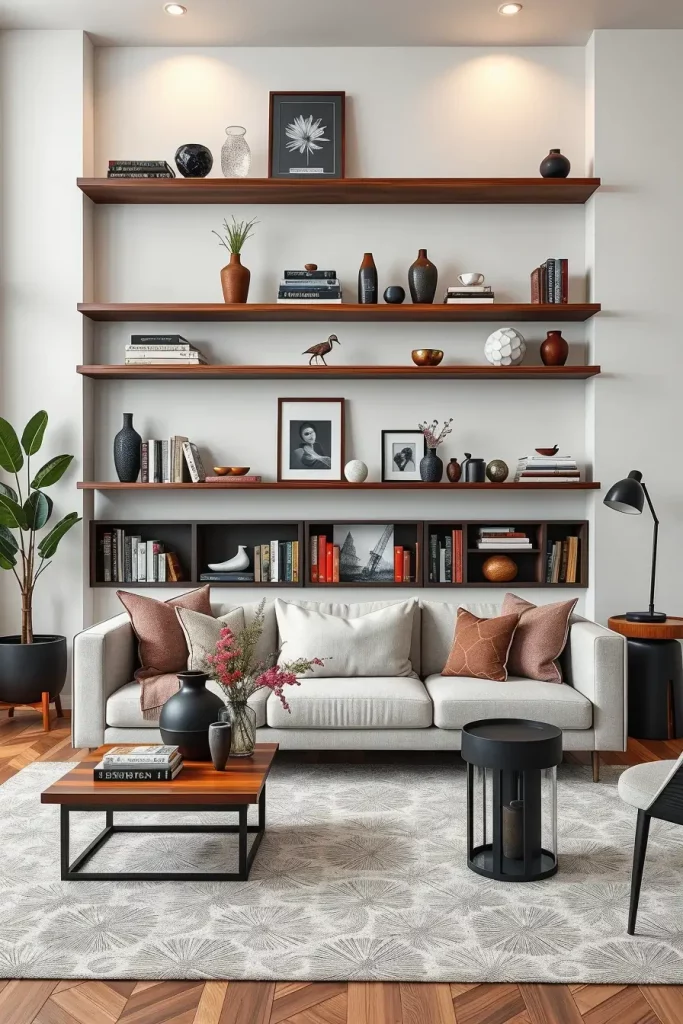
In my designs, I usually opt for metal and wooden shelves mounted on the wall in matte black or walnut walnut finish. They’re spaced to allow for different height, ensuring both appeal and practicality. It is my suggestion to stack books both vertically and horizontally while flanking them with vases, sculptures, or framed photos. The trick is maintaining balance while avoiding overcrowding.
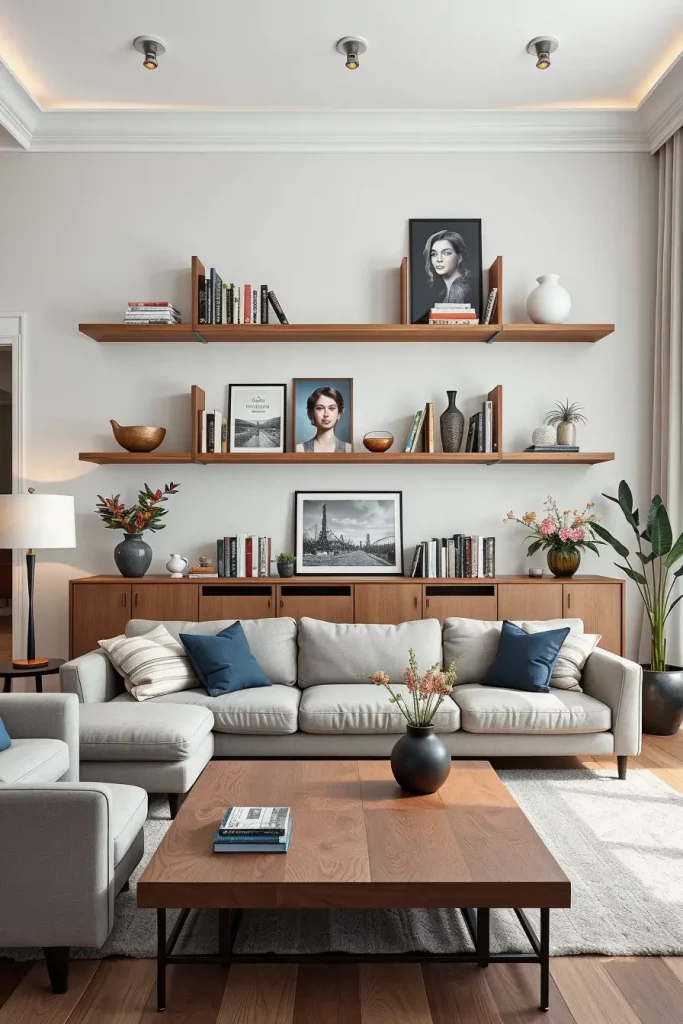
Elle Decor states that curated shelving contributes to “visual storytelling,” and I always recommend my clients change the items shown seasonally so the room feels fresh and lively.
If there is anything I could add to this idea, it is the option of select built-in lighting for particular shelves so key pieces could be highlighted while also creating ambient light during the evenings.
Hot Wood Tones In Modern Spaces
Wood serves as a vital counterbalance to the sharp lines and cold colors found in contemporary living room designs. I often use warmer woods such as honey oak, walnut, and cherry for their natural textures to give a softer feel. It helps make the room more inviting than sterile while simultaneously adding timeless elegance.
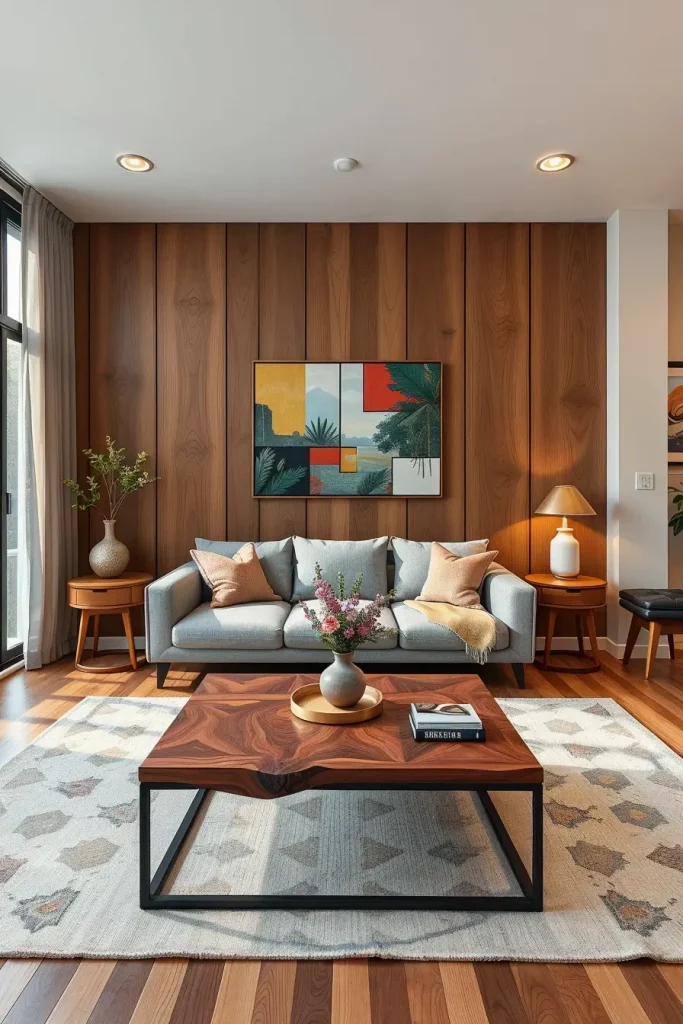
I prefer to use the same tone for all floating side tables, shelf units, media units, and even coffee tables to create a cohesive color palette. Warm toned media units and wood paneled accent walls can also anchor the room. Together with soft neutral fabric on the furniture and some understated metallics, this creates a cozy yet modern room.
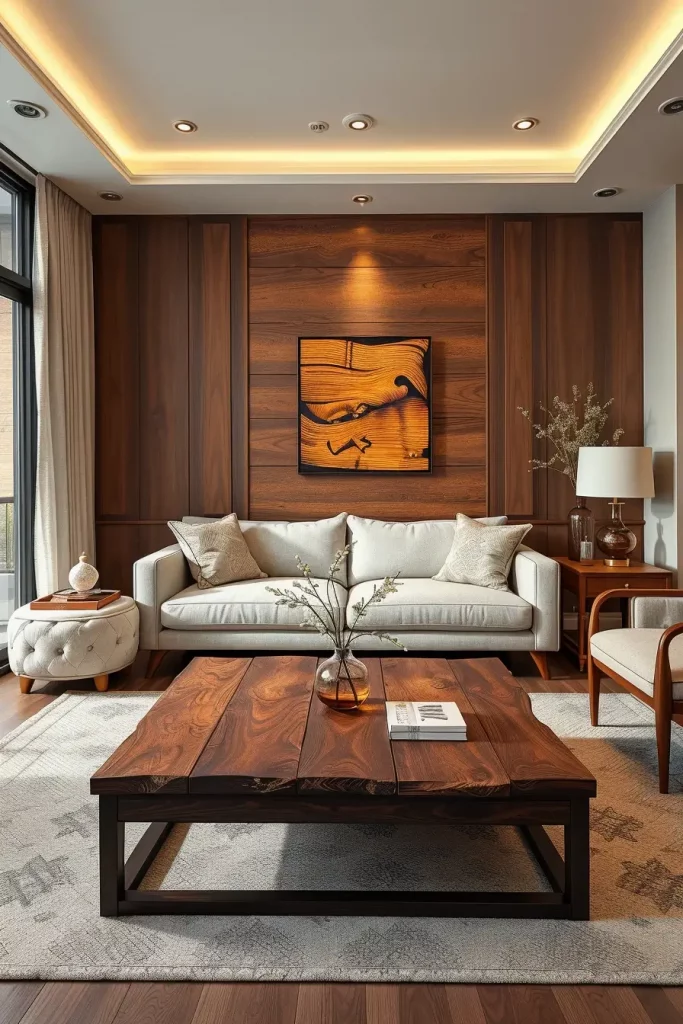
Like this blend of organic and industrial wood elements is praised in modern styling by Dwell to offset the chill of contemporary wood finishing. These finishes provide emotional warmth and tactile interest, which I would say makes a very solid case.
For more cohesive designs however, I would also look at using wood in window trims or beams if the architectural style allows.
Use Color Or Texture For Dramatic Accent Walls
Sometimes a living room needs something unforgettable. This is where I like the concept of accent walls. I have used vibrant colors, or materials that are more tactile such as stone, plaster, or wood slats to build focal points that capture attention and define the space. Such large additions anchor rooms and accentuate nuanced traits without overpowering the layout.
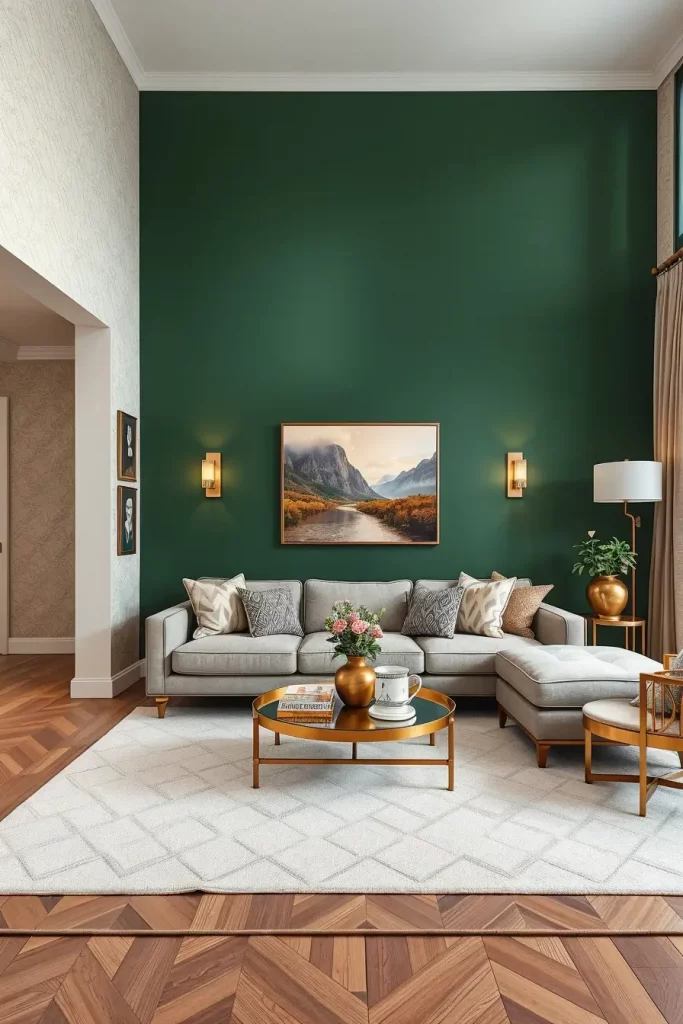
Some of my projects include deep blue or olive green paint behind the sofa, or textured wallpaper with metallic thread wallpaper. Other options also include slatted wood panels or textured plaster. These walls draw attention and contrast with muted surfaces. The key is to let one wall capture attention while the rest remain calm.
Designers at House Beautiful recommend a quiet color palette for accent walls and this has always worked for me. Accent walls paired with minimal frames and unobtrusive decorations always synergize very well, so it comes off looking elegant.
To push the idea further, I would add integrated shelving or recessed lighting to the accent wall for more functionality and depth.
Floating Fireplaces As A Focal Point
Ethanol and electric fireplaces serve as the perfect accent and can be mounted to walls or suspended from the ceiling. These floating fireplaces capture attention in contemporary-styled rooms and are ideal for open floor layouts. In addition, wall-mounted fireplaces cover more space while conserving room as these fireplaces add warmth and architectural intrigue.
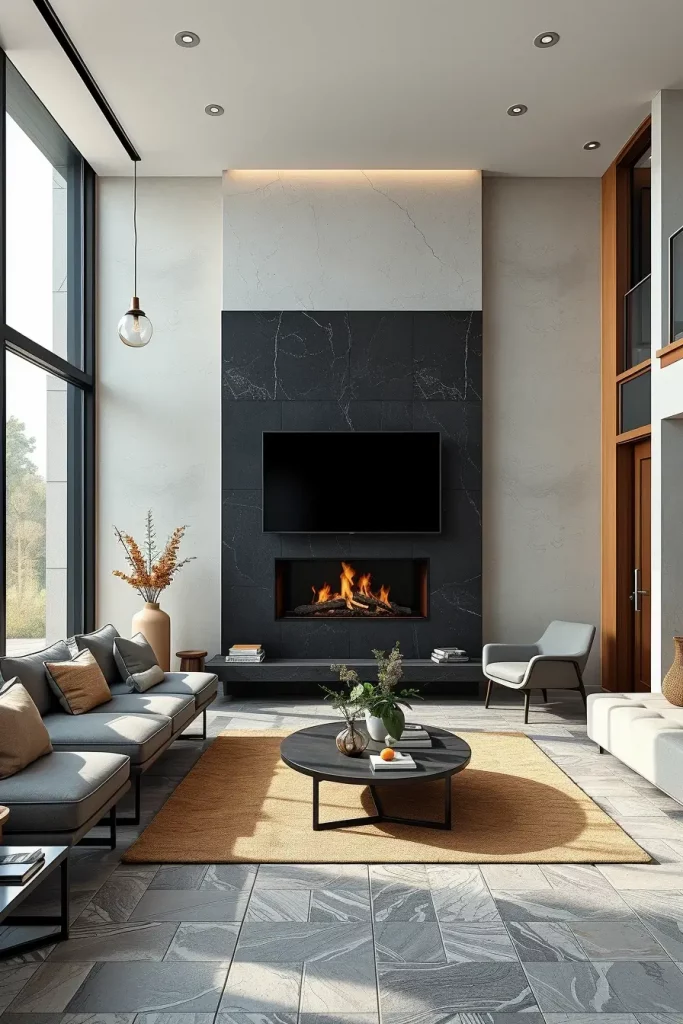
As a designer, I tend to gravitate towards sleek metal and stone finishes with clean lines. This is best paired with low-profile seating arranged around the flames. These floating fireplaces can serve as both functional and visual dividers in open-concept spaces.
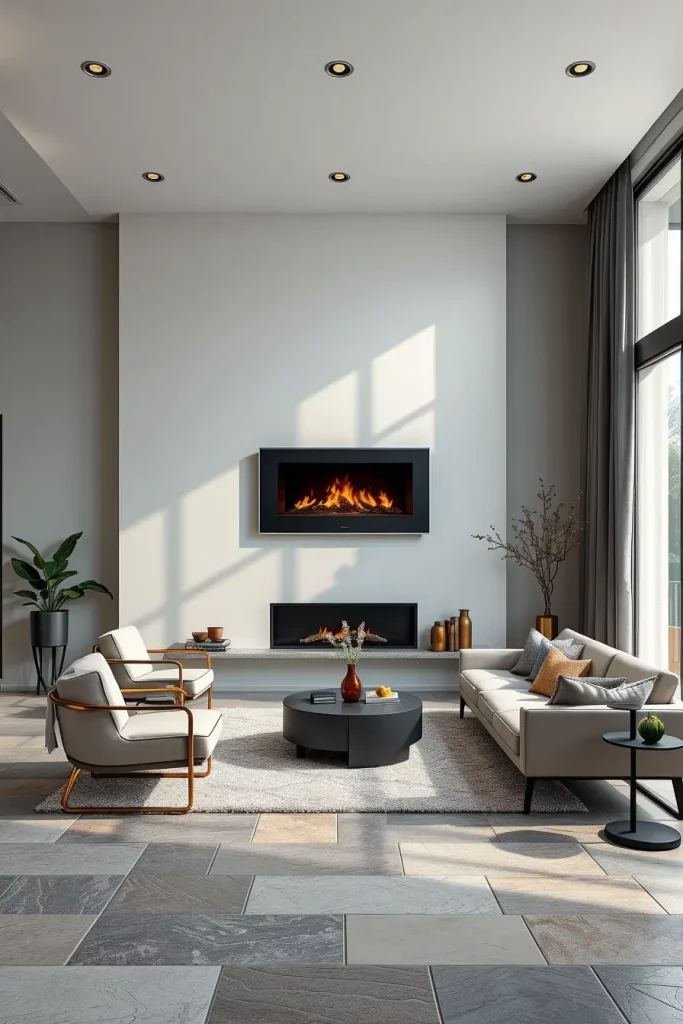
Interior Design Magazine touches on the integration of form and function, and I’ve seen many floating fireplaces meet that need beautifully. These fireplaces are also perfect for apartments that do not have traditional chimneys due to space limitations.
An ideal fireplace setup would require a hearth, but instead create a shadow line using a recessed base. This would also give the fireplace visual stability.
Combining Metals and Organic Elements
Combining surfaces like wood with metallic finishes is one of my favorite strategies to achieve contrast in living rooms. Incorporation of both extremes evokes warmth while still containing a sense of order. Consider brass vases on copiously elegant wooden tables, iron light fixtures on sofas draped with fine linen, or a beautifully crafted copper mirror hanging over a marble fireplace.
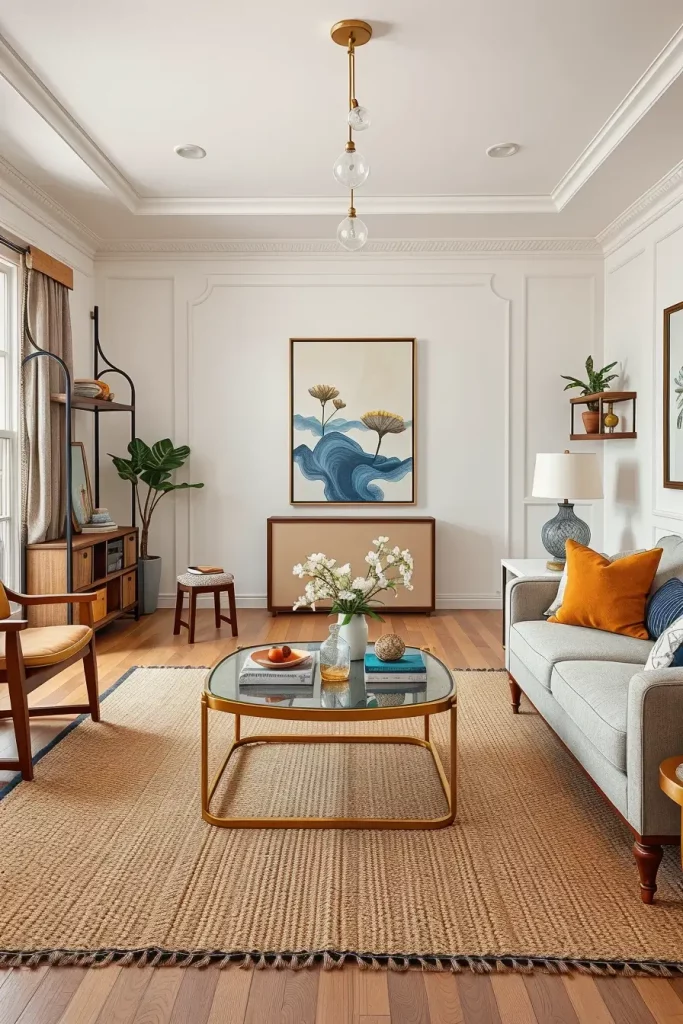
Robust steel offers a clean finish and is best accompained by soft organic cotton or wool fabrics. Matte brass coffee tables alongside woven jute rugs work wonderfully too. To add contrast of hardness and softness, I incorporate marble or stone which creates a balanced interplay of cold and warm textures.
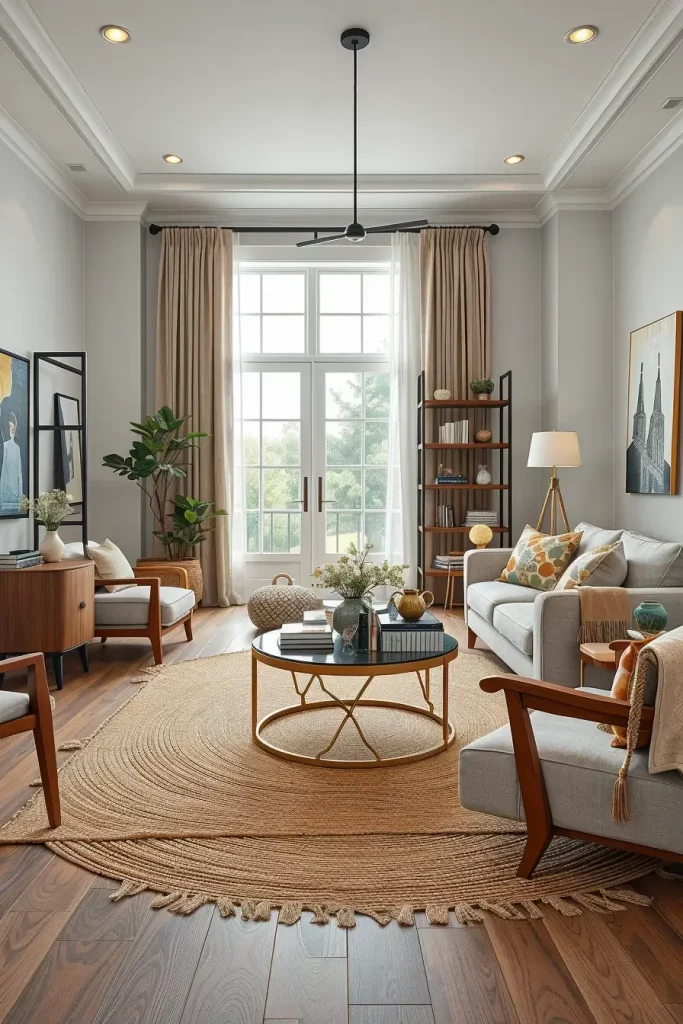
Veranda’s experts from the magazine are best known for advocating this pairing stating how it modernizes natural materials and softens industrial ones. In my experience, it’s not often that duality allows me to personalize contemporary spaces without straying into eclectic or cluttered territory.
For achieving better results effortlessly, I’d recommend starting from reclaimed wood and commplementing sculptural metal pieces which portrays the essence of sustainability alongside craftsmanship.
Sculptural Furniture As Functional Art
From all the modern homes I have worked on, sculptural furniture is one of the best ways to add character into a contemporary living room design. Not only does this bring about beautification, it allows the sculptural furniture to serve as a centerpiece and a talking point. I firmly believe that in every home, these pieces serve more than a decorative purpose. They have boundless functionality while integrating mechanism into design.
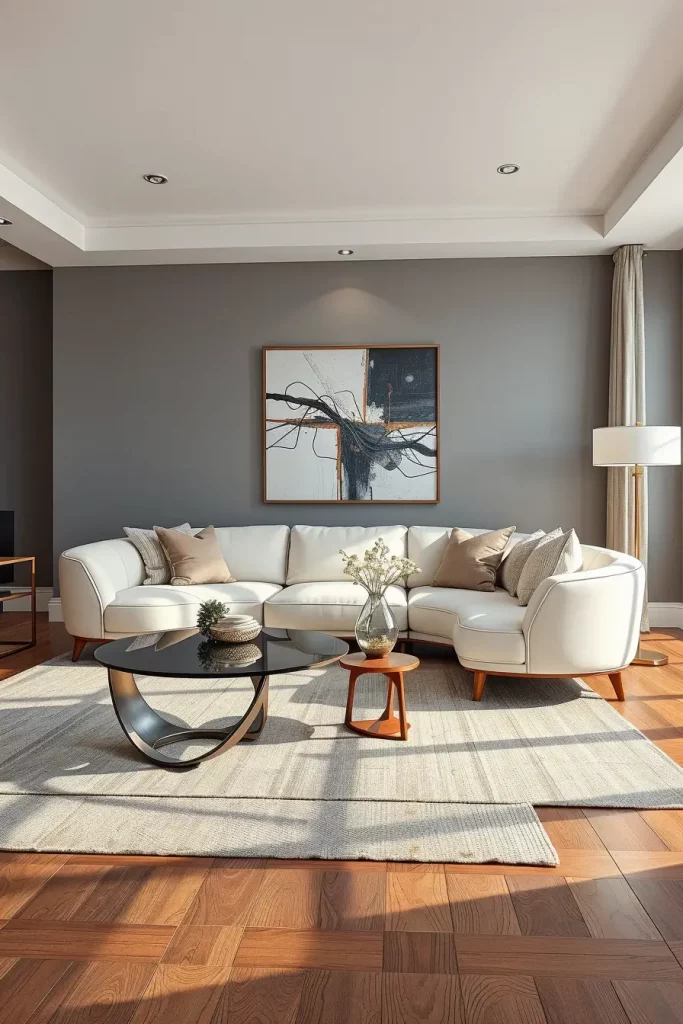
These types of furniture include a curved sofa or couch, which can be paired along with a coffee table made of twisted metal. You could even incorporate a chaise lounge that is designed like a wave. Organic shapes, unique matte finishes, and silhouettes that set them apart from traditional furniture makes these pieces stand out. Whenever I incorporate sculptural furniture into a design, I usually place it alongside minimal surrounding elements. These include neutral walls, calm rugs, and simple lighting.
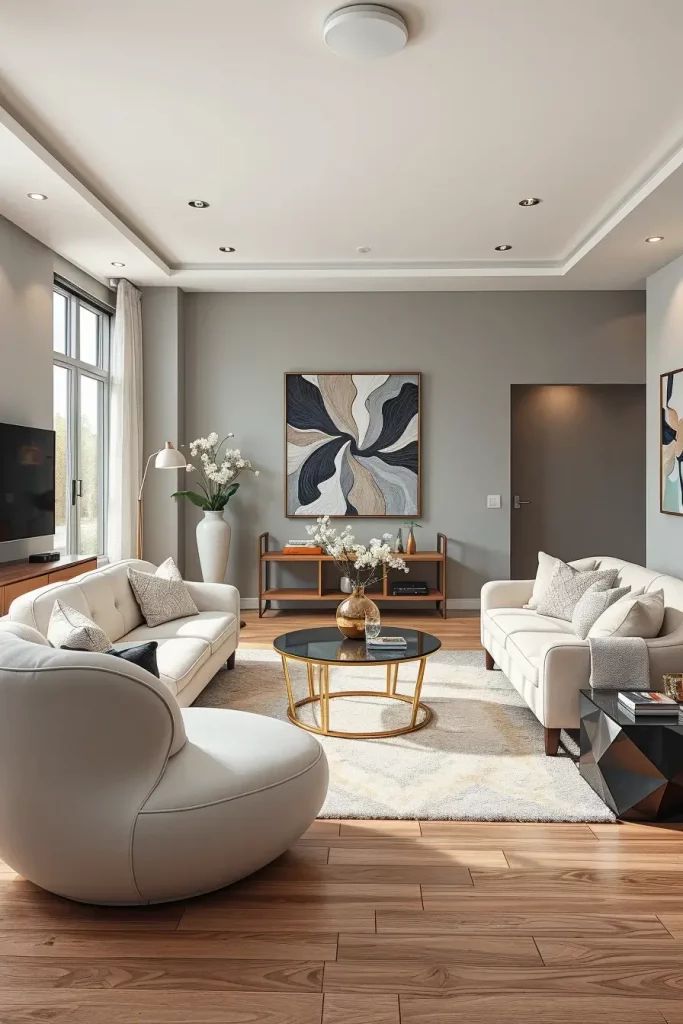
There is undeniable proof that artistic pieces enhance the look and comfort of one’s home. Janet Wearstler stated sculptural design not only focuses on beautifying a piece but allows the user to create “intimacy,” which in this case would be the warm redesigns that transform the user’s experience on the furniture.
To complete this room, I would add either an abstract wall sculpture or a minimal floor lamp with architectural features. This reinforces the visual that the main pieces of middle furniture evoke and completes the contemporary aesthetic.
Keeping It Light: Pastels In Contemporary Spaces
Soft pastel shades are returning to contemporary living rooms. These colors evoke feelings of gentleness and softness, and many people shy away from them for this reason. However, modern interiors stand to gain from blush, muted mint, and powder blue. I always incorporate balance and work with one or two pastel shades—never more—against white or taupe walls to keep the space feeling elegant instead of sickly sweet.
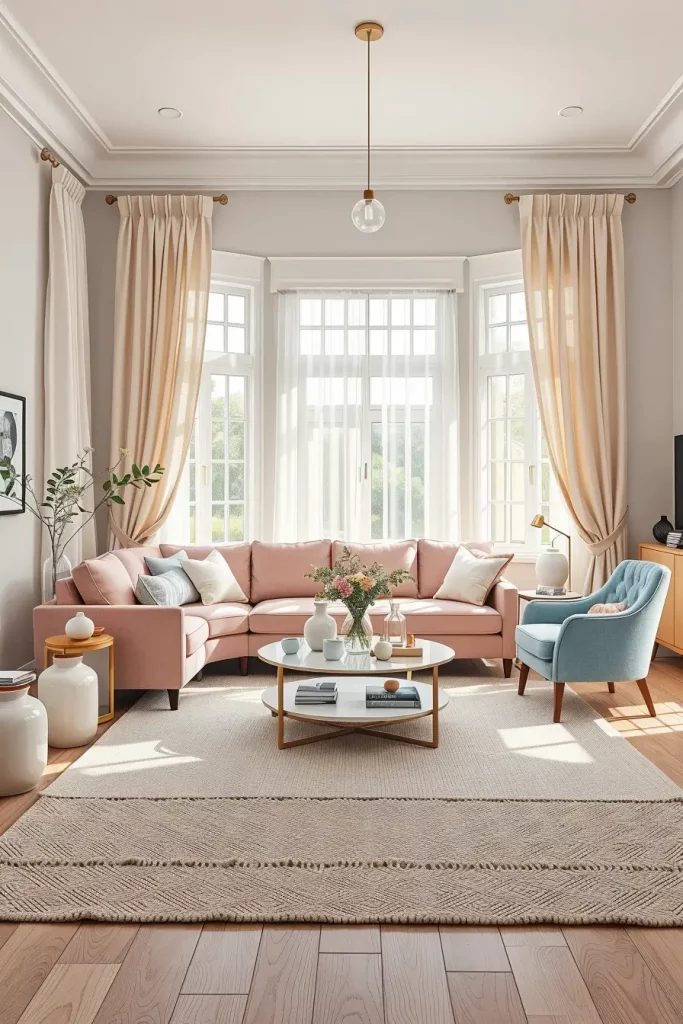
These colors dominate the furniture and accents selection. I for one tend to prefer pale pink sectional sofas with them or consider a sky blue armchair set on a neutral wool rug. The effect is complemented with soft curtains, abstract art pieces in pastel tones, and ceramic vases in faint colors. These tones reflect sunlight entering the room, which makes it feel much more spacious and welcoming.
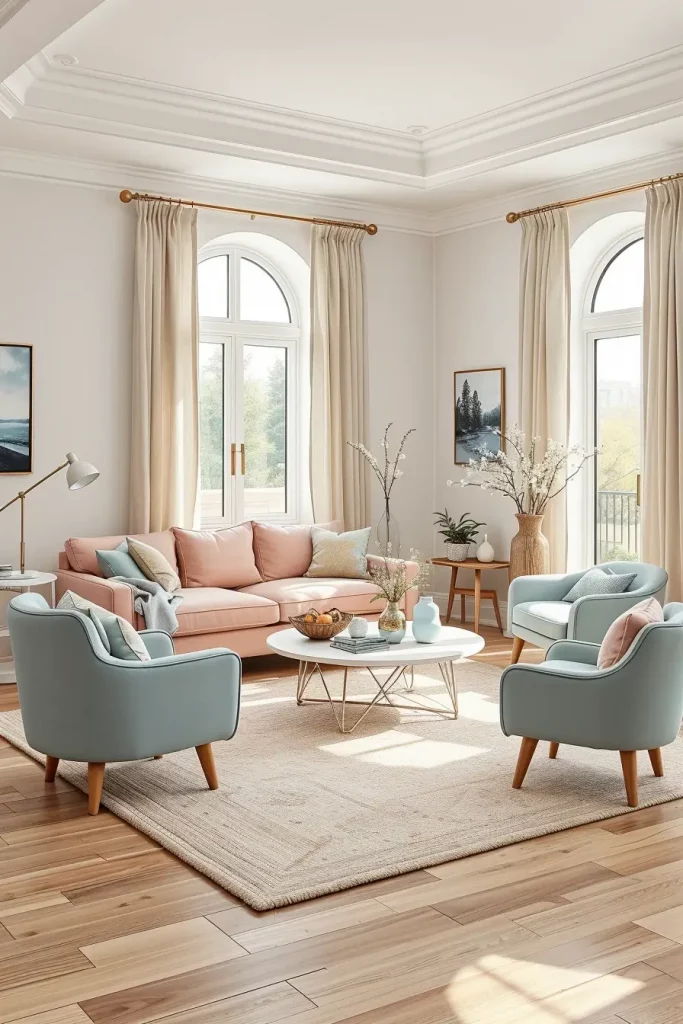
Soft tones bring about a sense of calm, an essential need in areas designated for lounging and recharging. In Elle Decor, designer Shawn Henderson mentioned, “Color in a quiet voice can still have powerful effects.” I have especially come to appreciate that when trying to balance aesthetics for clients who want a more modern look but without the cold feel of minimalism.
If I were to take this room’s feel further, I might place soft pastel pendant lights or a dusty rose wall feature behind the sofa. It remains calm without going too feminine or into dated territory.
Harmonizing The Living Room With Other Areas
In most contemporary living room designs, an issue I often face is lack of connection between spaces. With modern homes, the living room is almost always an open design with the dining rooms, kitchens, or sometimes even the stairway, so it has to integrate beautifully. For me, the answer lies in seamless consistency of visuals and textures. In this case, working with my clients step by step makes the outcome much smoother. Together, we decide on the color palettes, materials, and even design elements that foster cohesion.
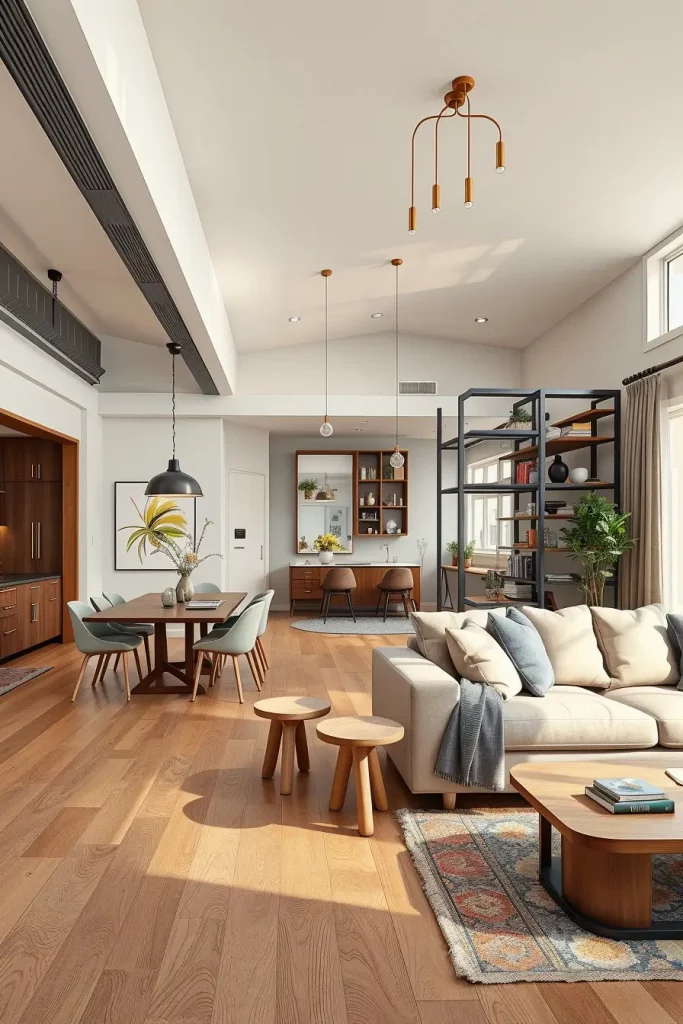
I generally start with a primary material, such as natural oak or brushed steel, and apply it to the legs of the furniture, lighting, and door hardware. Area rugs in walls’ toned hues and covered-backed ceiling treatments, like recessed lighting, further integrate the spaces. For this purpose, I often recommend modular furniture or fixed elements like shelving that function as room dividers while preserving openness.
Based on my experience, this helps create the illusion that the entire floor is larger and more intentional. In House Beautiful, designer Nate Berkus said, “Your home should feel like a thoughtful story, not a set of unrelated chapters.” When you do bring together your spaces, that story is told beautifully.
What else could be added to improve this layout? Incorporating a sculptural element or artwork visible from both areas can serve as a focal point that connects the two zones while anchoring the viewer’s gaze.
Staying Timeless And Modern At The Same Time
There is a risk of following smash hits when designing a modern living room. For me though, the danger lies within designing based on what is trending. Trying to stay relavant is done through forefront accents, not defining frameworks. The essence of the approach is that the space remains relevant for years, not just months. For the space, smart lighting, well-designed layout, and timeless investment pieces like a quality wood coffee table or sofa serve as the backbone.
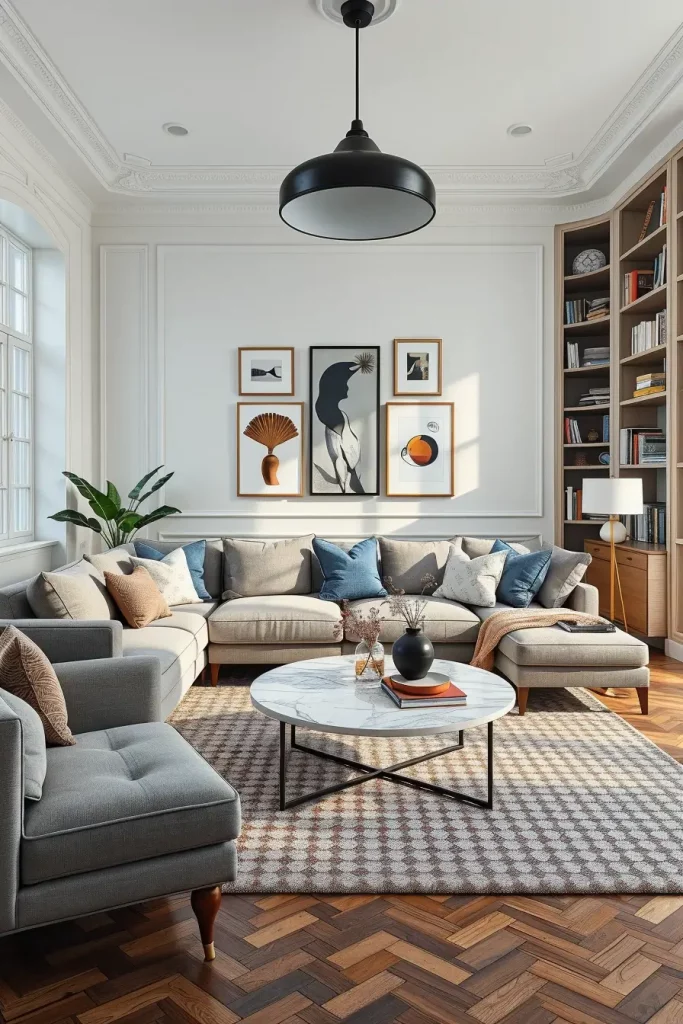
To keep feeling trendy, accent pieces that can be easily interchanged do the trick. Think: black matte light fixtures, terrazzo trays, boucle throw pillows, or checkered area rugs for example. The best part about these additions is that they reflect the latest trends that pillow the room without committing to any fad. Phenomenal wallpaper or bold paint colors also allow for style experimentation while providing flexibility.

In my own projects, I’ve kept to this model. My clients are grateful that their living rooms remain visually appealing without the need for a full renovation every few seasons. “Contemporary design is less about keeping up and more about refining your environment with deliberate ease,” said Veranda Magazine.
To refine this particular space, I would incorporate a bookshelf that serves as a display case for sculptural art pieces and art books—both modern and traditional—thereby melding different styles without completely starting over.
Modern design of the living room gives great opportunities to blend style, comfort, and practicality. Whatever your preference, be it flowy spatial integration, smooth pastels, or sculptured furniture, the approach taken is what matters the most since it should align with your individual tastes and preferences. I am eager to learn how everyone else is modernizing their own homes so please do share your comments and questions below!
